Recent opioid settlement spending-related resources:
“How Are Opioid Settlement Funds Being Spent So Far?”
co-authored by Christine + a few of her excellent colleagues for Health Affairs Forefront
State-Level Guides for Community Advocates on Opioid Settlements
the official encyclopedia of every state’s opioid settlement spending rules, co-produced with Vital Strategies
“With Big Tobacco’s cautionary tale shadowing these debates, the issue of accountability looms. Who ensures that grantees spend their money appropriately? What sanctions will befall those who color outside the lines of their grants?
So far, the answers remain to be seen. Christine Minhee, a lawyer who runs the Opioid Settlement Tracker, which analyzes state approaches to spending the funds, noted that on that question, the voluminous legal agreements could be opaque.
‘But between the lines, the settlement agreements themselves imply that the political process, rather than the courts, will bear the actual enforcement burden,’ she said. ‘This means that the task of enforcing the spirit of the agreement — making sure that settlements are spent in ways that maximize lives saved — is left to the rest of us.’”
— "Opioid Settlement Money Is Being Spent on Police Cars and Overtime" (The New York Times)
This page documents states’ plans for their opioid settlement winnings.
For the birds-eye view of opioid settlements reached thus far, visit the Global Settlement Tracker (quick jump: States’ Opioid Settlement Statuses).
Opioid Settlement Funding Opportunities (UPDATED WEEKLY)
This section hosts opioid settlement-funded grant opportunities. It collects all of the state and local grant RFPs I used to embed throughout my “Allocation Plans” spreadsheet, which I will be replacing later this year.
State-Level Guides for Community Advocates on Opioid Settlements (UPDATES FORTHCOMING)
Vital Strategies and I created this encyclopedic set of guides in June 2023 to equip community advocates with expert-level analyses of the many opioid settlement spending plans I’ve been tracking since 2021. These Community Guides will be updated later this year.
States' Opioid Settlement Allocation Plans (ARCHIVAL FORTHCOMING)
From June 2022 to March 2024, this spreadsheet was updated weekly to track state-specific opioid settlement plans and news. It lists every state’s opioid settlement spending plans and displays each state’s allocation of funds across state and local coffers. Given that it tracks pending legislation as well, it may fairly be considered the superset of the Plaintiffs’ Executive Committee’s NationalOpioidSettlement.com.
As of April 2024, Christine will no longer be updating the “LIVE SPENDING UPDATES” column with state-specific opioid settlement spending news. The results of her weekly news tracking will instead appear as part of a forthcoming update to her and Vital Strategies’ Community Guides.
Opioid Settlement Spending Webinars and Explainers
A collection of my mini-lectures about the opioid settlement spending landscape.
Settlement Spending FAQs
Will states be misspending their opioid settlement dollars?*
Why have states’ opioid spending plans taken the form of contracts and legislation?*
“How Are Opioid Settlement Funds Being Spent So Far?” (Health Affairs Forefront)
*Excerpted from my greater Opioid Settlement FAQs page.
OPIOID SETTLEMENT SPENDING OPPORTUNITIES (UPDATED WEEKLY)
(This is a new section; formatting updates are forthcoming.)
This section tracks all of the opioid settlement-related funding and feedback opportunities I come across in my weekly Google Alerts trawling. It is the superset of the state and local listings embedded throughout my original States’ Opioid Settlement Allocation Plans spreadsheet, which I plan to retire and replace later this year. All feedback welcome.
Delaware — Prescription Opioid Settlement Distribution Commission: Listening Tour Survey (live)
Georgia — Opioid Abatement Trust: Notice of Funding Opportunity (DUE 5/17), informational workshops (in-person 4/29, 5/13)
Idaho — Idaho Behavioral Health Council: Fiscal Year 2026 Opioid Recommendation Process (DUE 5/15)
Illinois: Adams County — grant application (live)
Indiana: Evansville — Opioid Settlement Fund Application (DUE 5/15)
Iowa: Polk County — Request for Grant Applications (FY2025-26): Supports for People with Lived Experience (DUE 5/22)
Kentucky — Kentucky Association of Counties: Leadership Institute: Opioid Settlement Funds - Best Practices (virtual 4/18)
Maryland — Opioid Restitution Fund Priorities Survey (live), Advisory Council’s Vacancy Announcement (two positions; applications live)
Massachusetts
Boston — Boston Public Health Commission: Opioid Settlements Project Director (live)
Falmouth — grant application (DUE 5/31)
Hampshire County — survey (live) (“Hampshire HOPE – the region’s countywide coalition focused on the impacts of opioid use – in collaboration with Hampshire County communities, is conducting this survey and will be sharing the results with the municipalities in the county”)
West Springfield — Opioid Settlement Community Feedback Form Request for Information (live)
Michigan — Opioid Advisory Commission: Community Impact Survey (live)
Cass County — Opioid Settlement Funds: Request for Funding Application (live) (“Proposals will be reviewed … within 14 days of submission”)
Minnesota
Minneapolis — Opioids Community Survey (live)
Steele County — Funding Survey (live)
New Jersey: Montclair — Opioid Prevention Programming Interest Survey (live) (see related, 11/7 coverage)
New Mexico: Albuquerque & Bernalillo County — opioid settlement consultant RFA (live)
North Dakota — Opioid Settlement Fund Grant: Notice of Funding Opportunity (several rounds), Opioid Settlement Advisory Committee: Special Meeting Notice (in-person and virtual 4/15)
Ohio — OneOhio Recovery Foundation: 2024 Regional Grant Request for Proposals (DUE 5/3), regional information sessions (4/22), and impact academy webinar series (“Topic: Evidence Base”) (4/15)
See also Funding for Kinship Families Impacted by the Opioid Epidemic (live)
Tennessee: Shelbyville — Opioid Grant Application (DUE 4/15)
Texas — Opioid Abatement Fund Council: Naloxone Program Grant (DUE 5/7)
Virginia — Opioid Abatement Authority: correctional facilities webinar series (4/24)
DBHDS Region 2 & Northern Virginia Opioid Response Network — survey for input (live)
Washington: King County — Expanding Access to MOUD Services in Community-based Settings (DUE 4/30)
West Virginia — Community Education Group: 2024 Syndemic Summit Conference (5/19-21)
Clarksburg — Opioid Settlement Funding Requests (live)
Kanawha County — Opioid Settlement Funds Application (live)
Wisconsin — Opioids, Stimulants, and Trauma Summit (in-person and virtual 5/7-9)
Eau Claire County — Opioid Task Force: Opioid Funding Prioritization survey (live)
Last updated April 21, 2024. The above contains everything I used to track using my States’ Opioid Settlement Allocation Plans spreadsheet, which I plan to archive later this year. If you see something I’ve missed, email Tips@OpioidSettlementTracker.com.
STATE-LEVEL GUIDES FOR COMMUNITY ADVOCATES ON OPIOID SETTLEMENTS
2024 UPDATES FORTHCOMING*



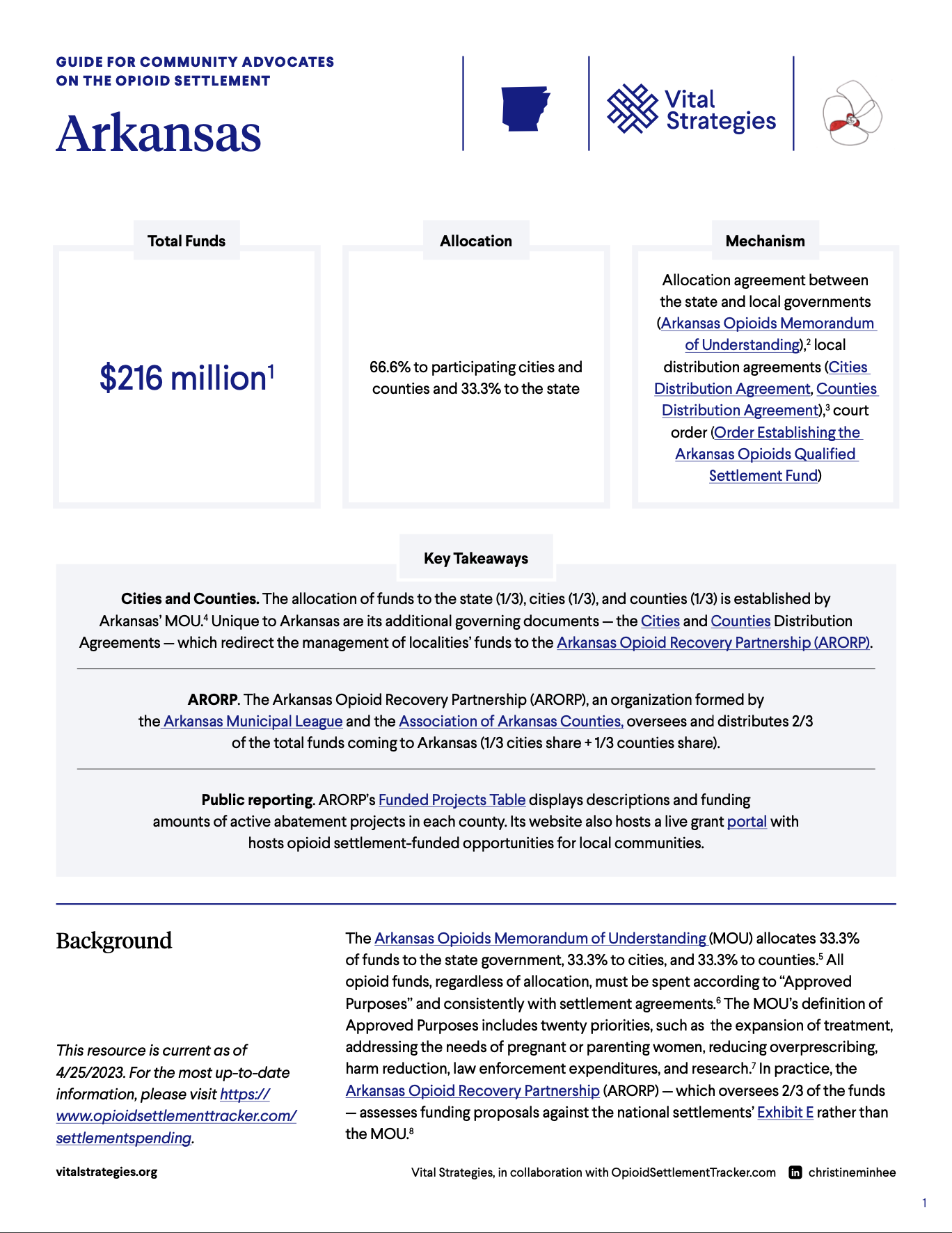


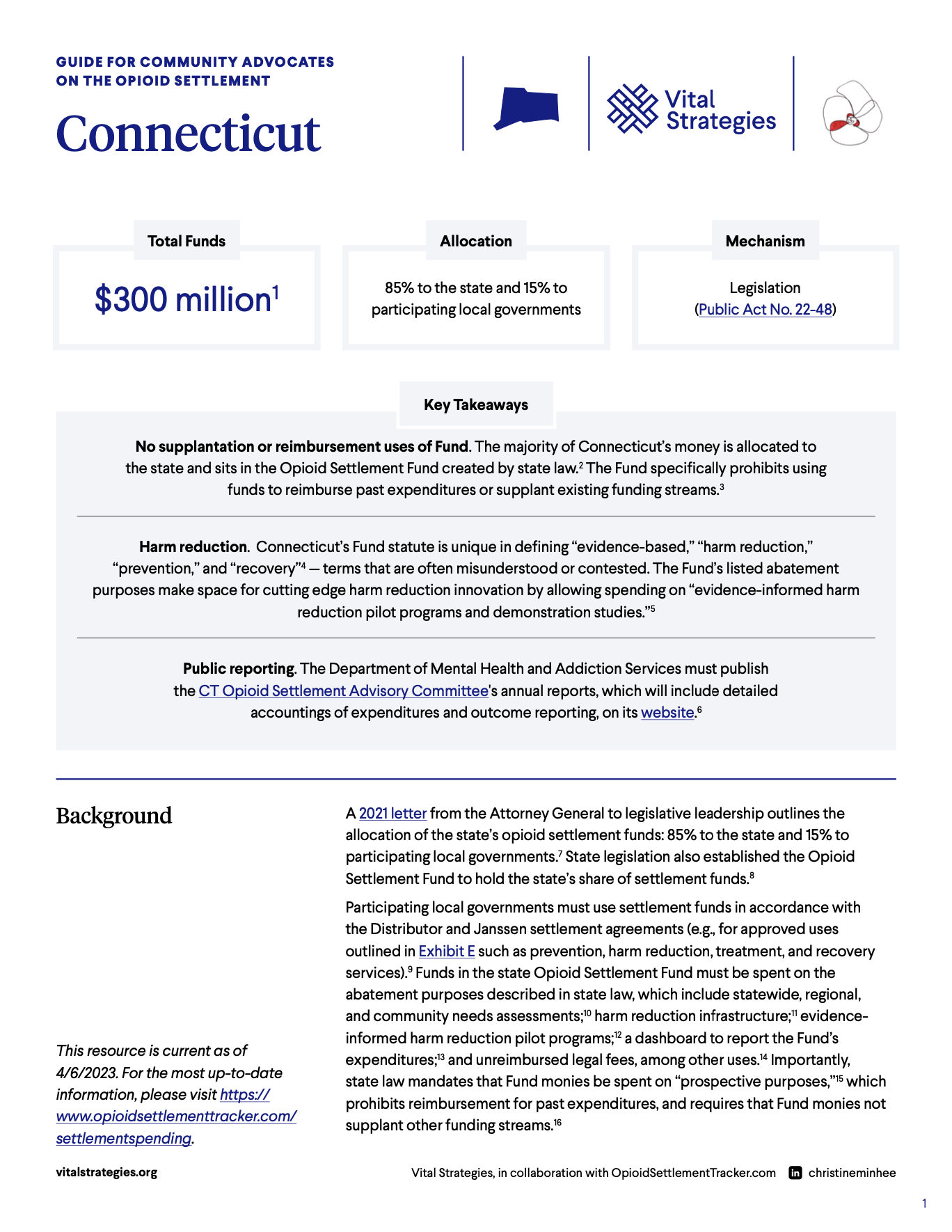
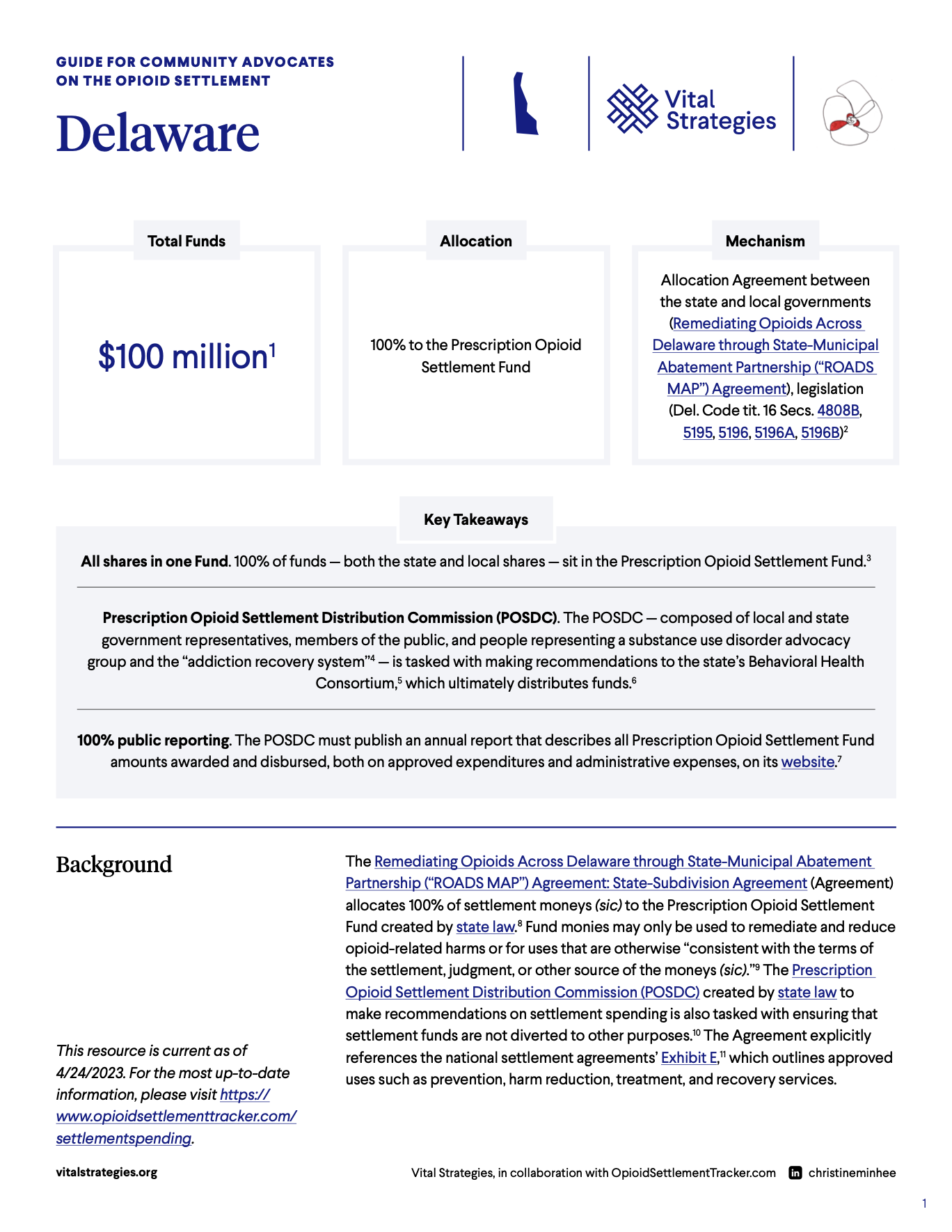


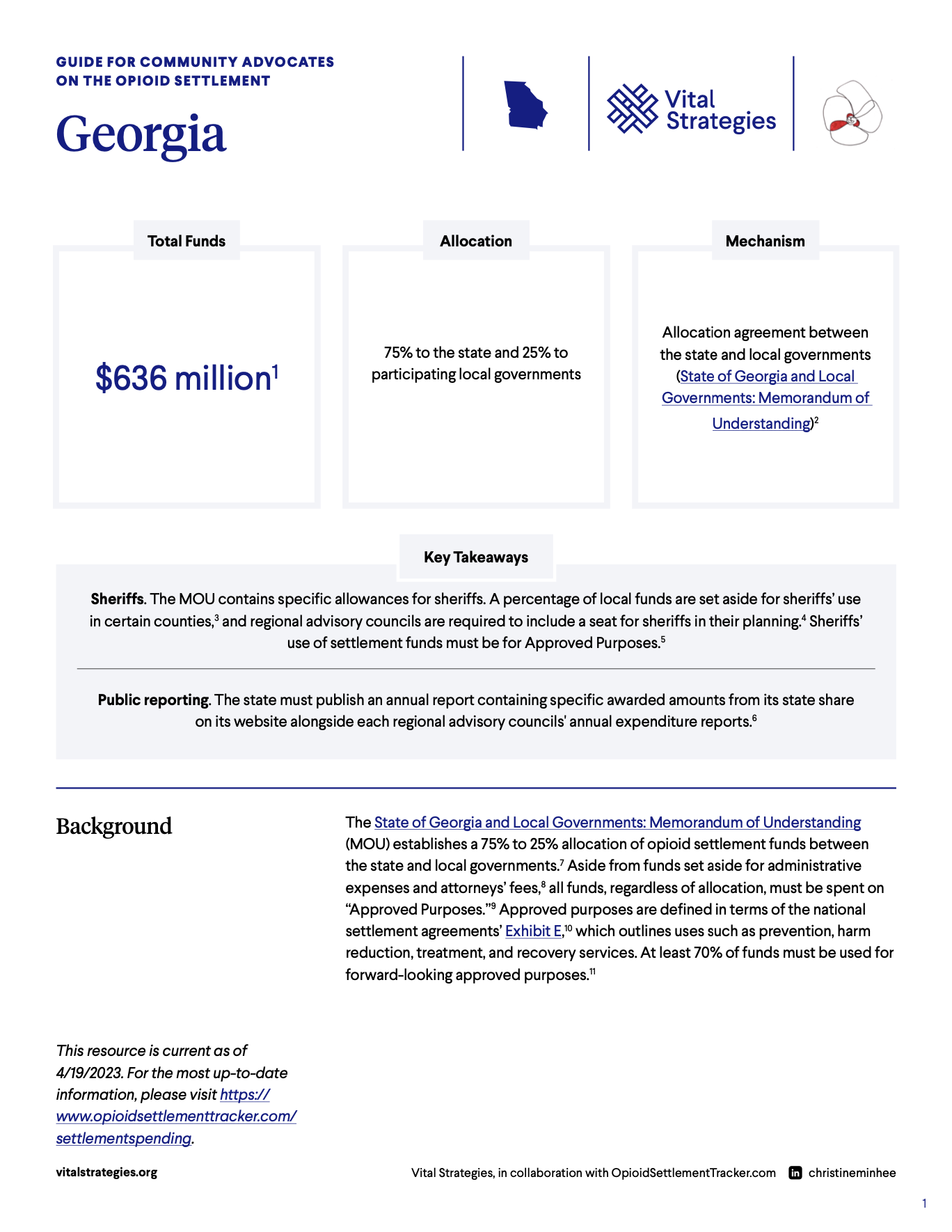
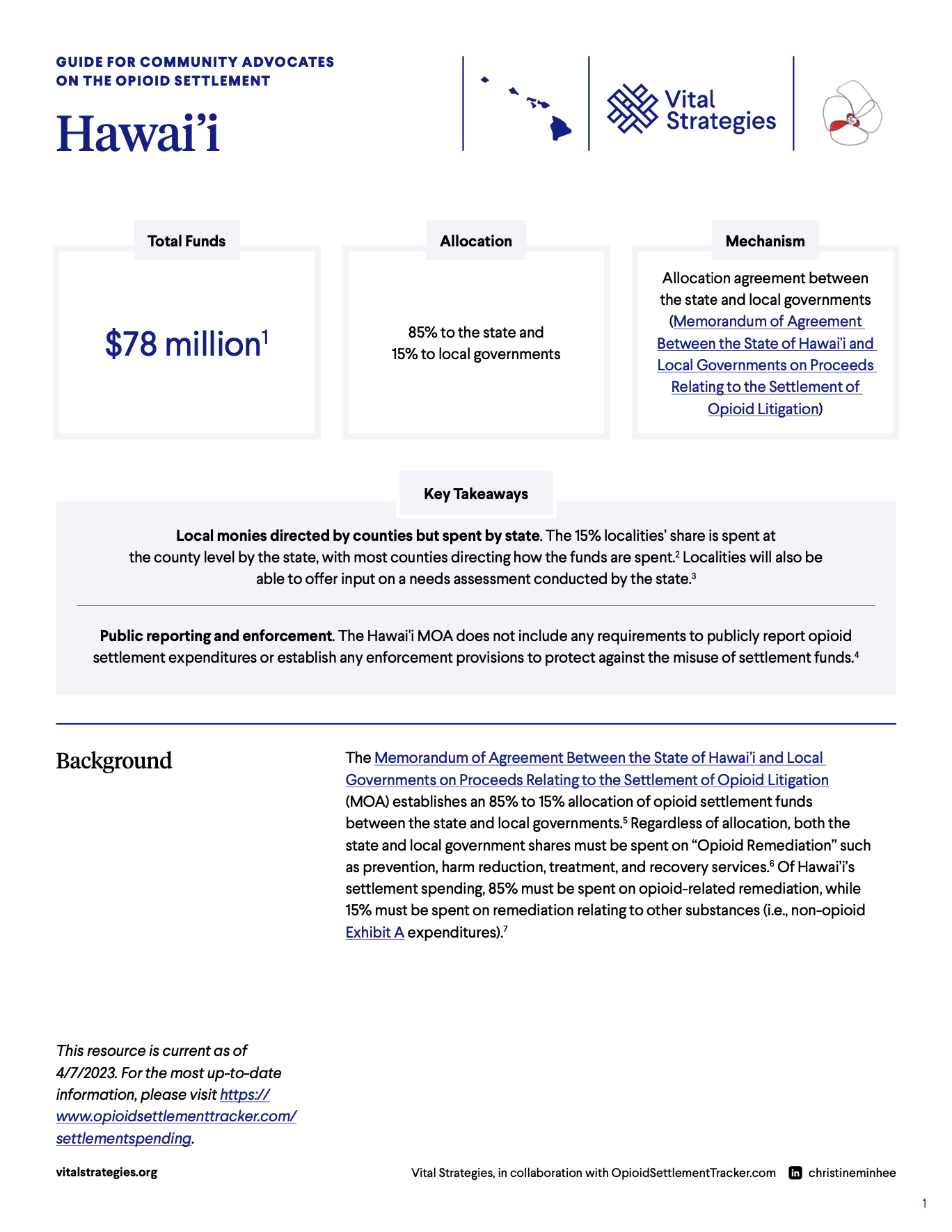
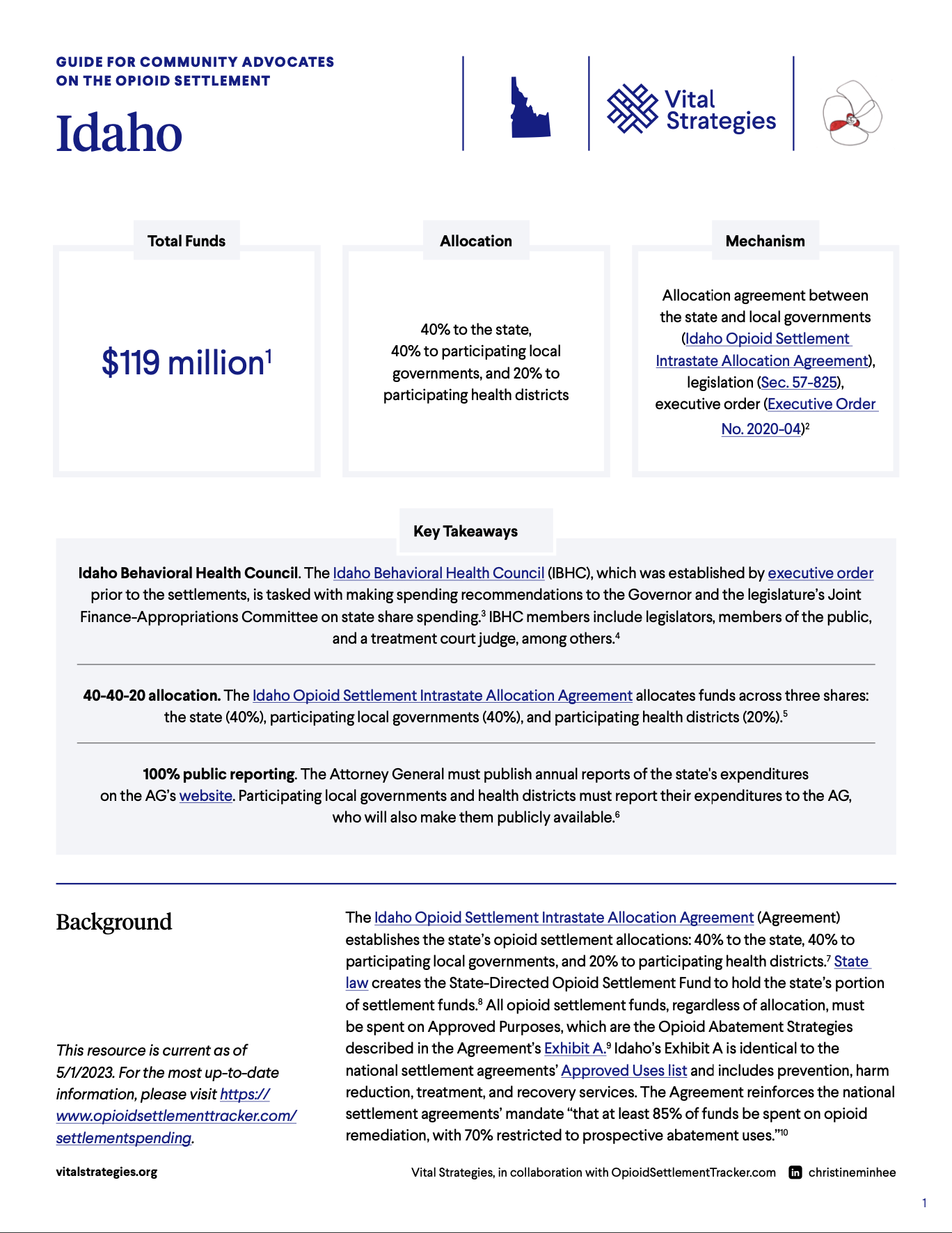
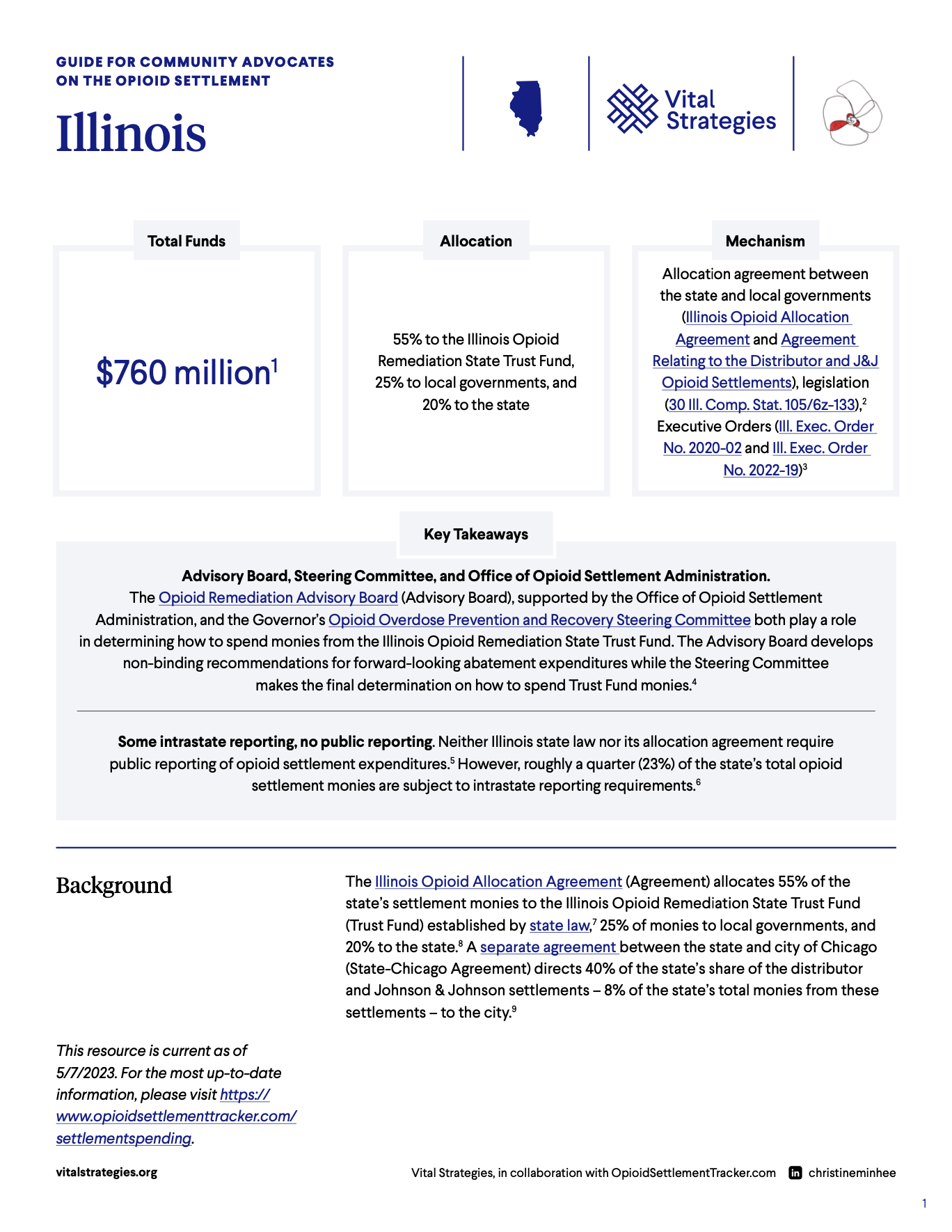
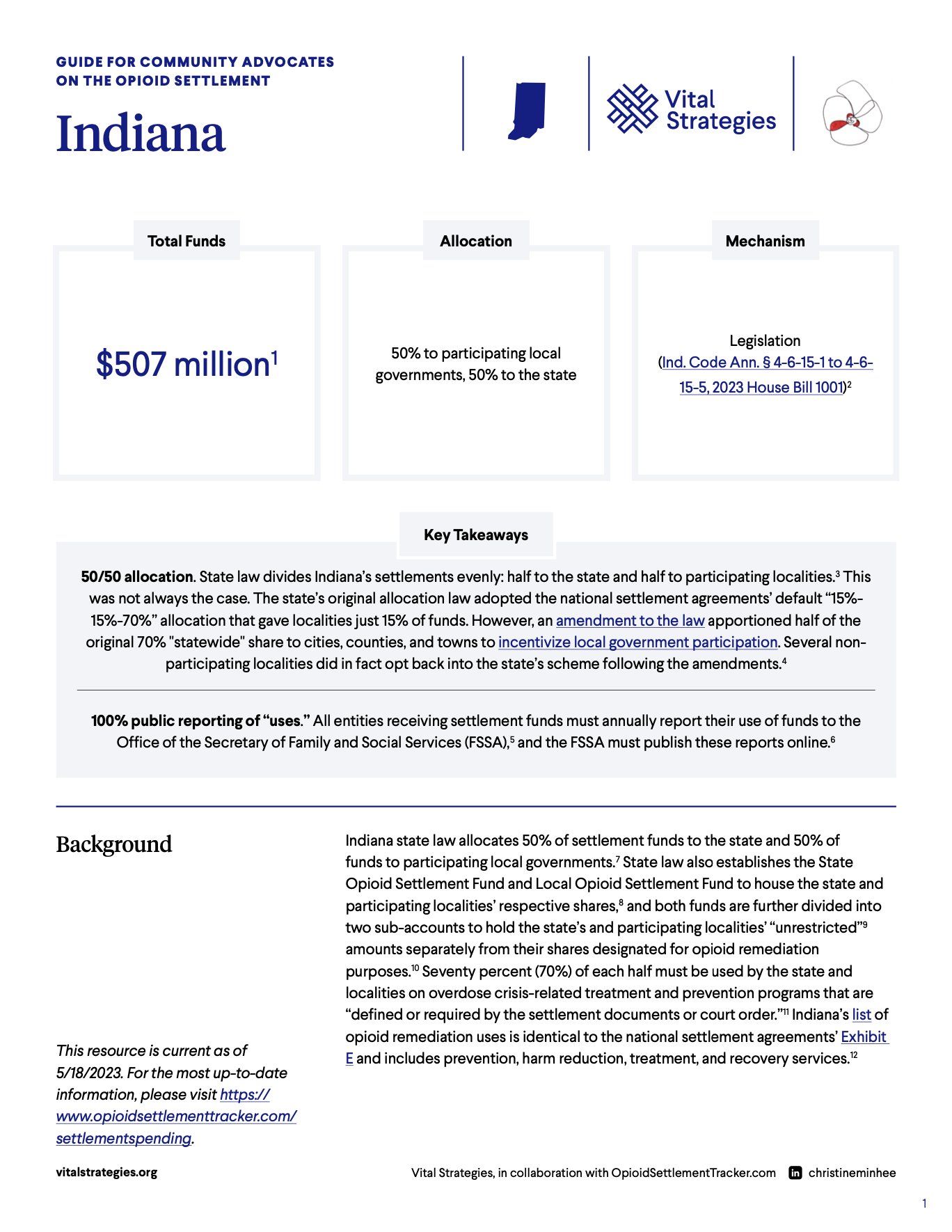
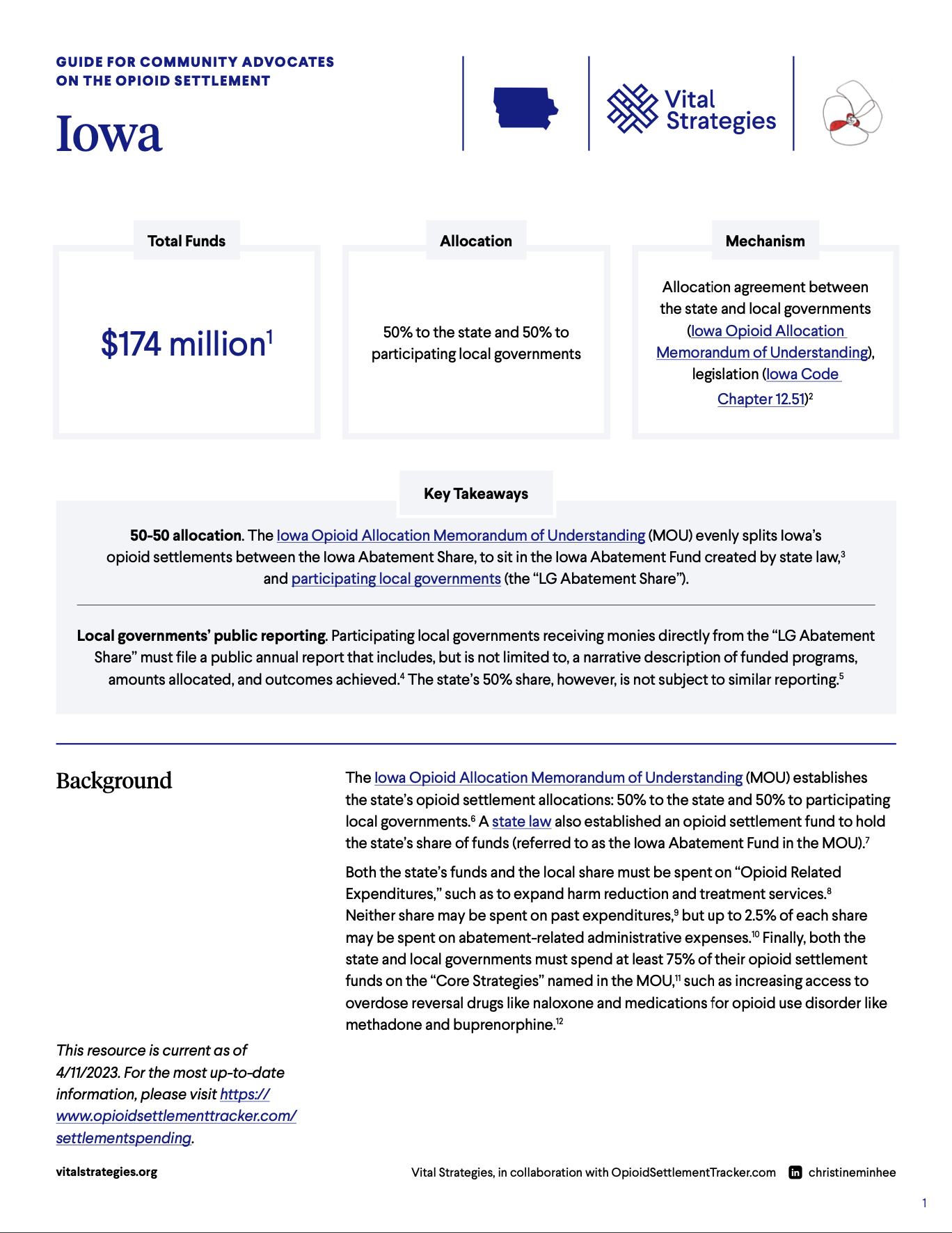
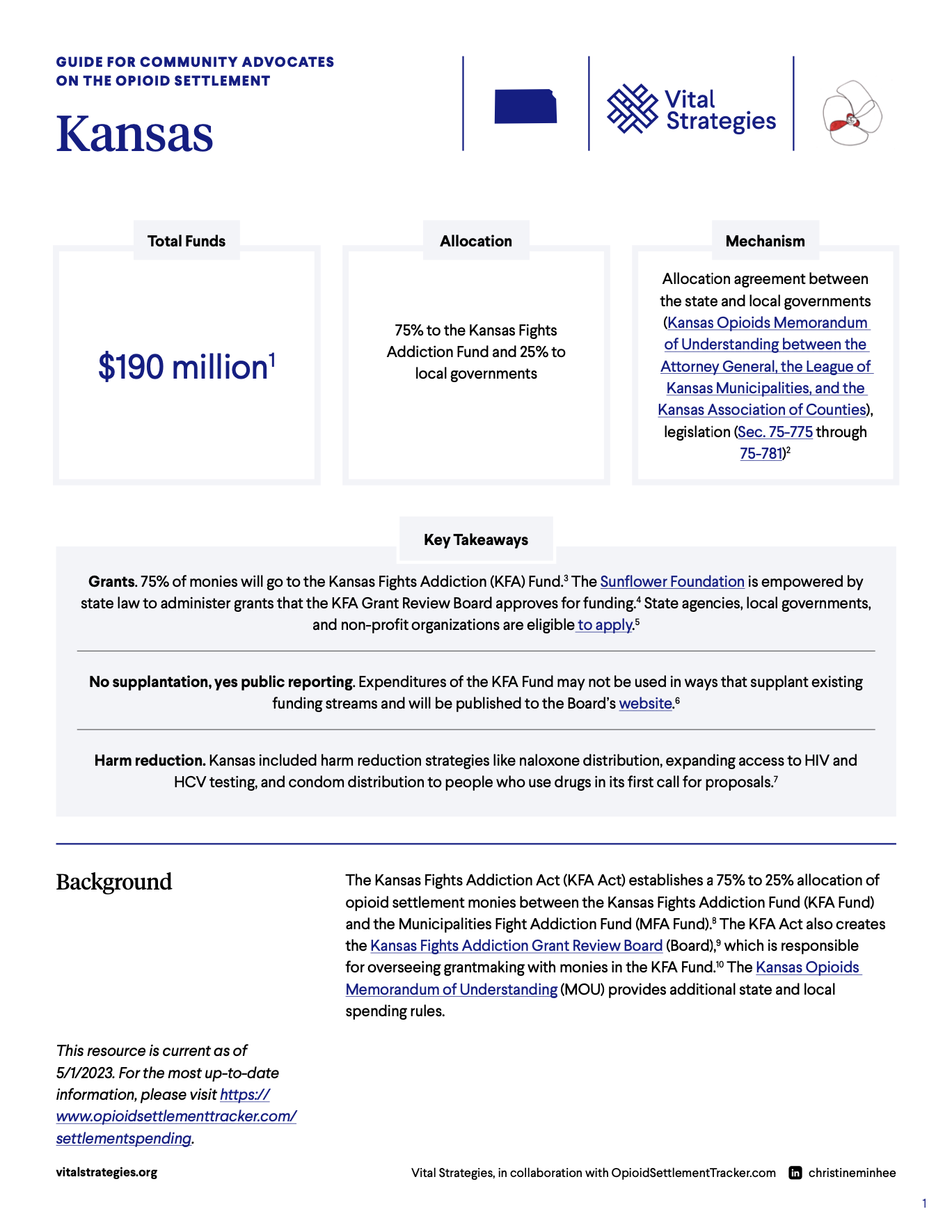
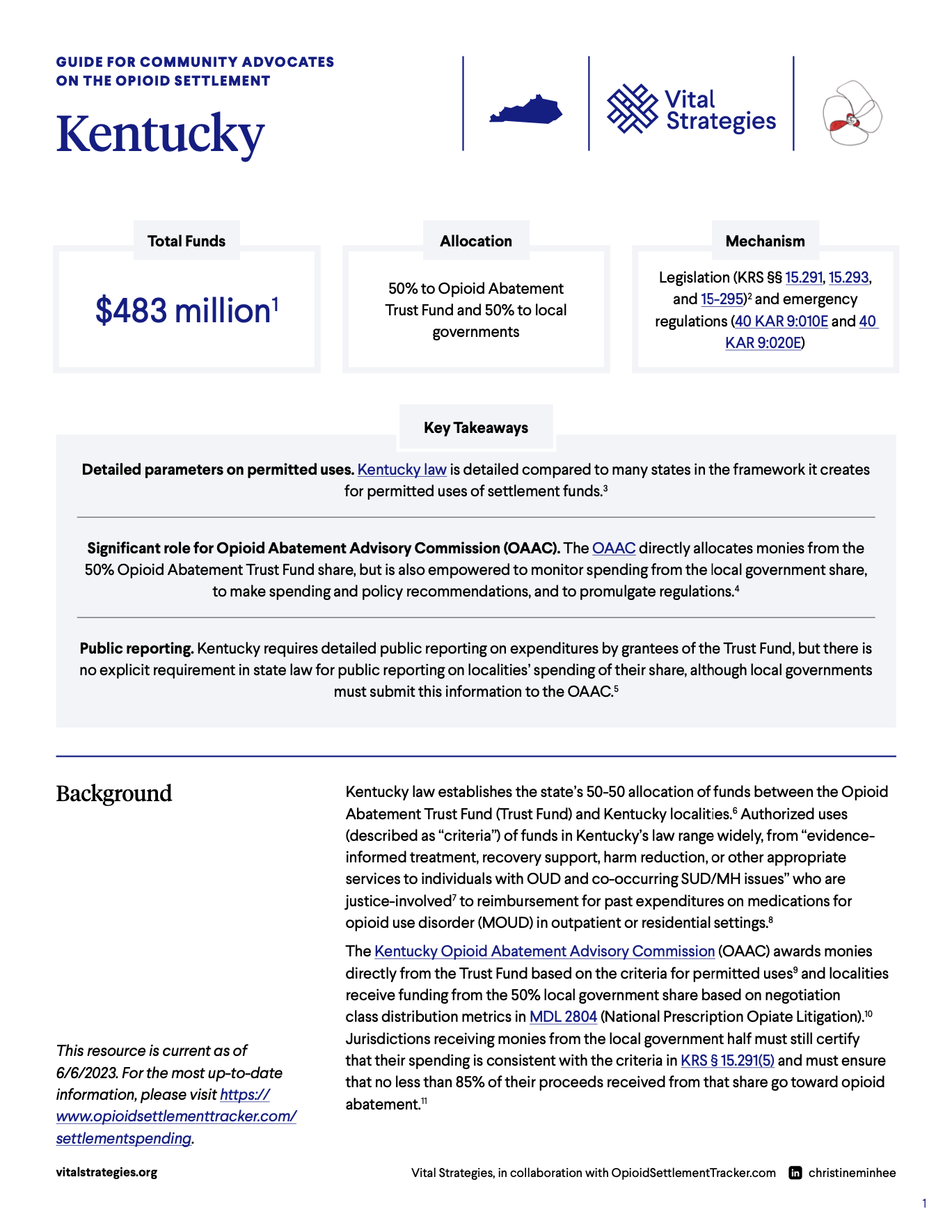

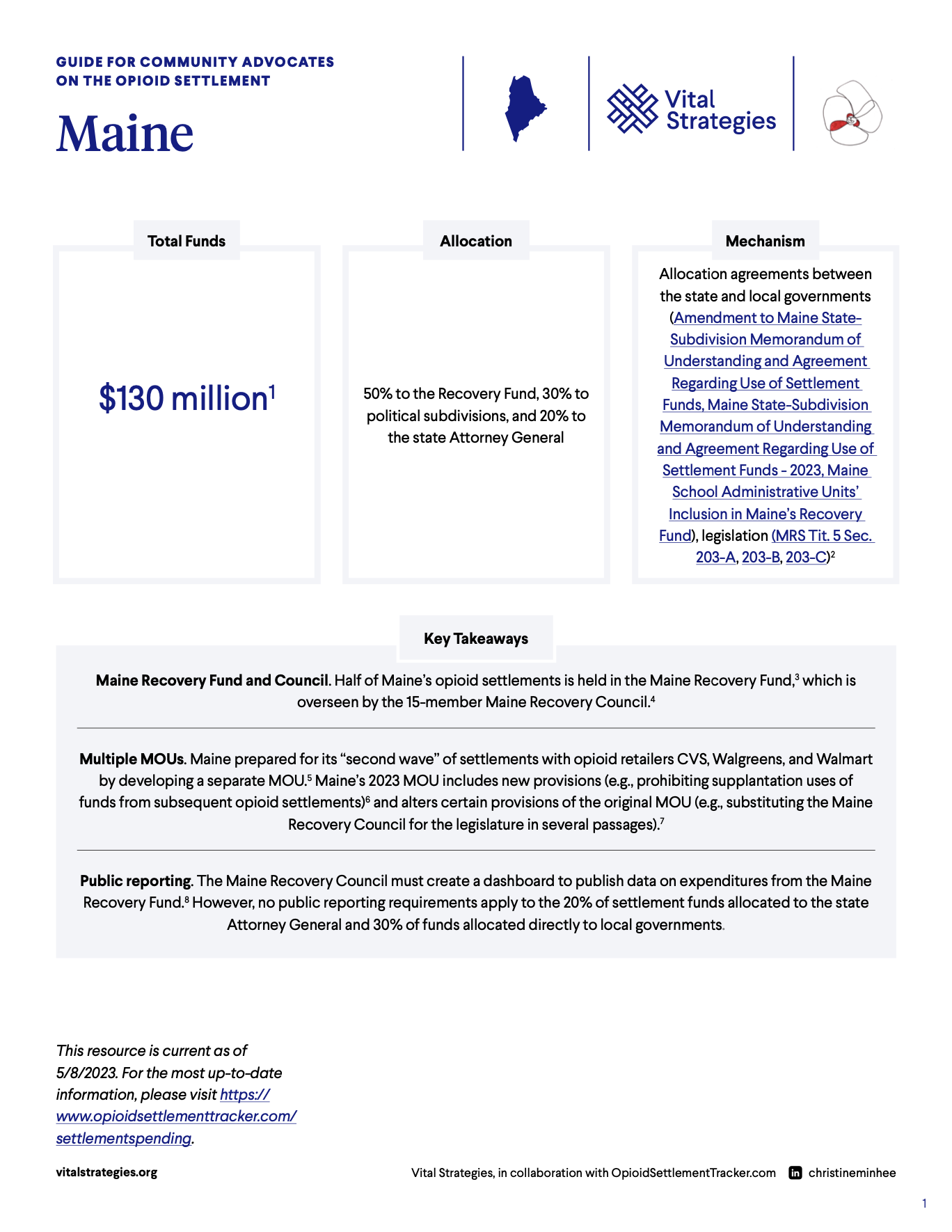
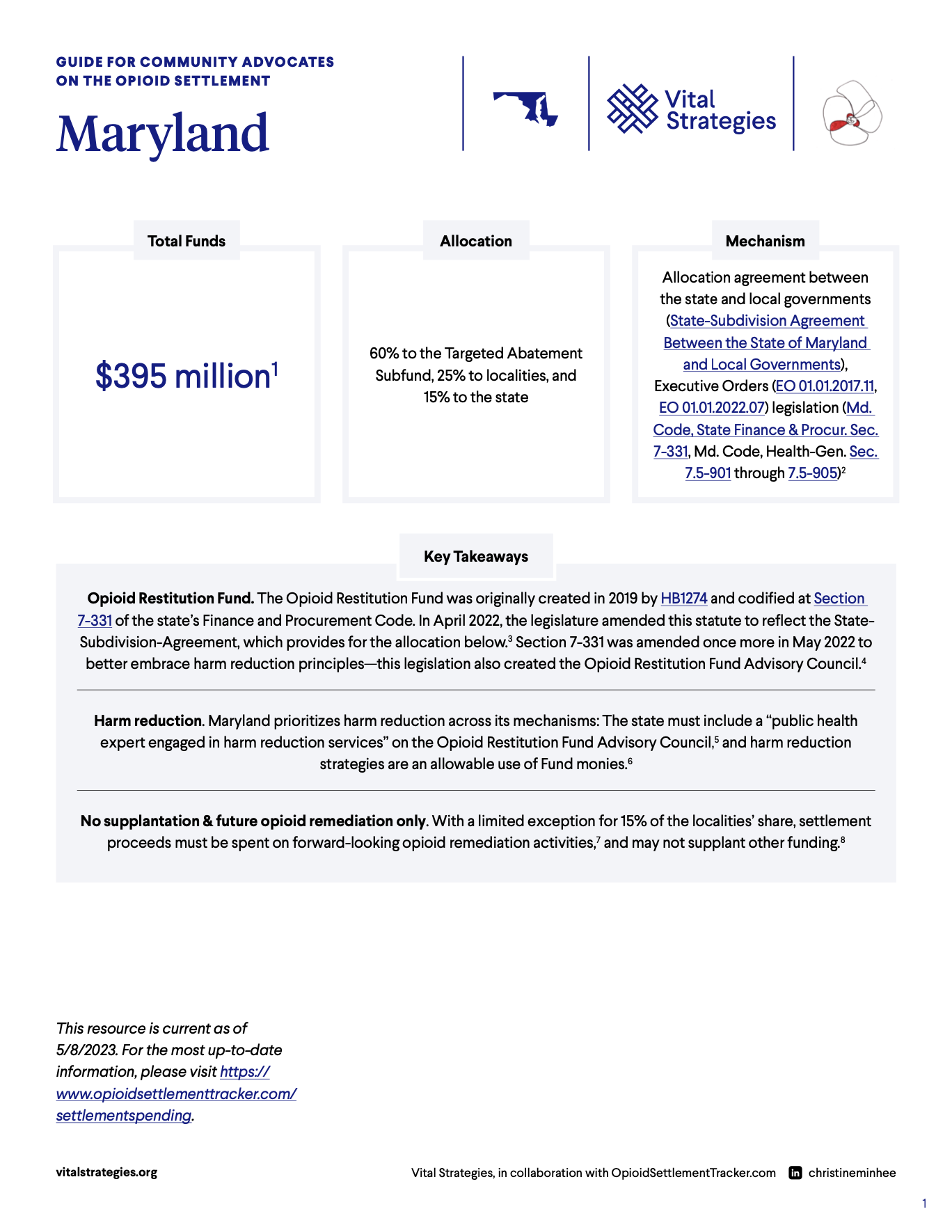
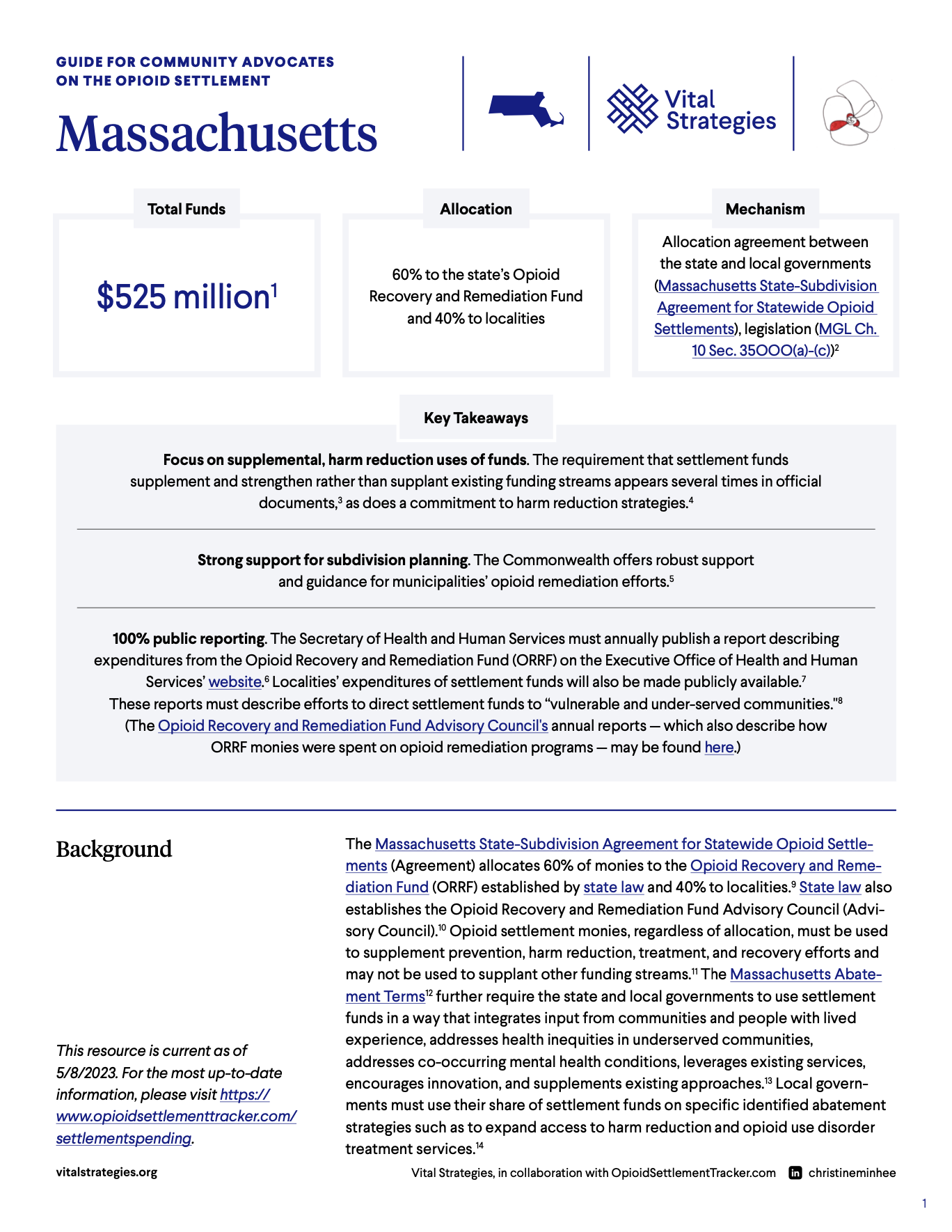


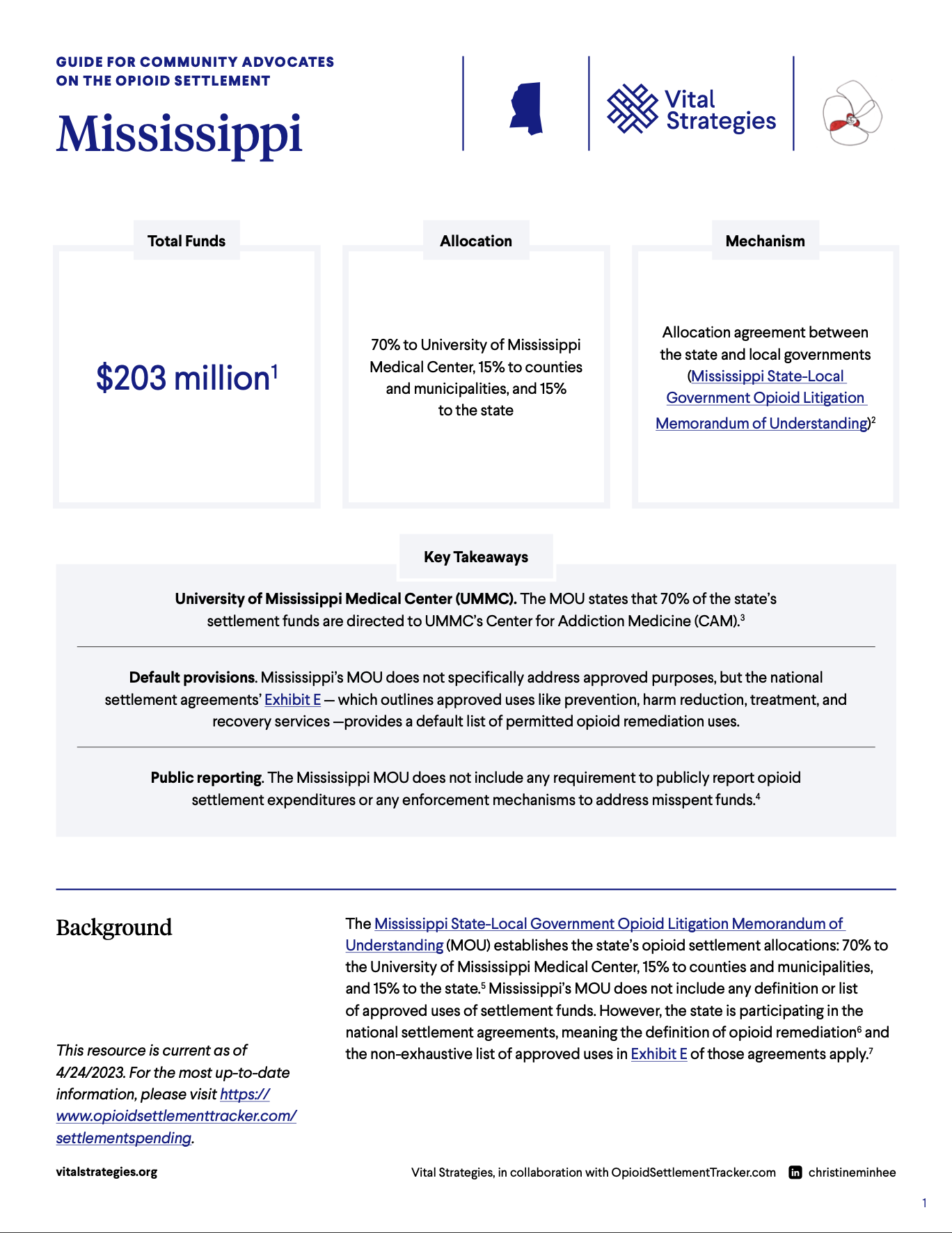
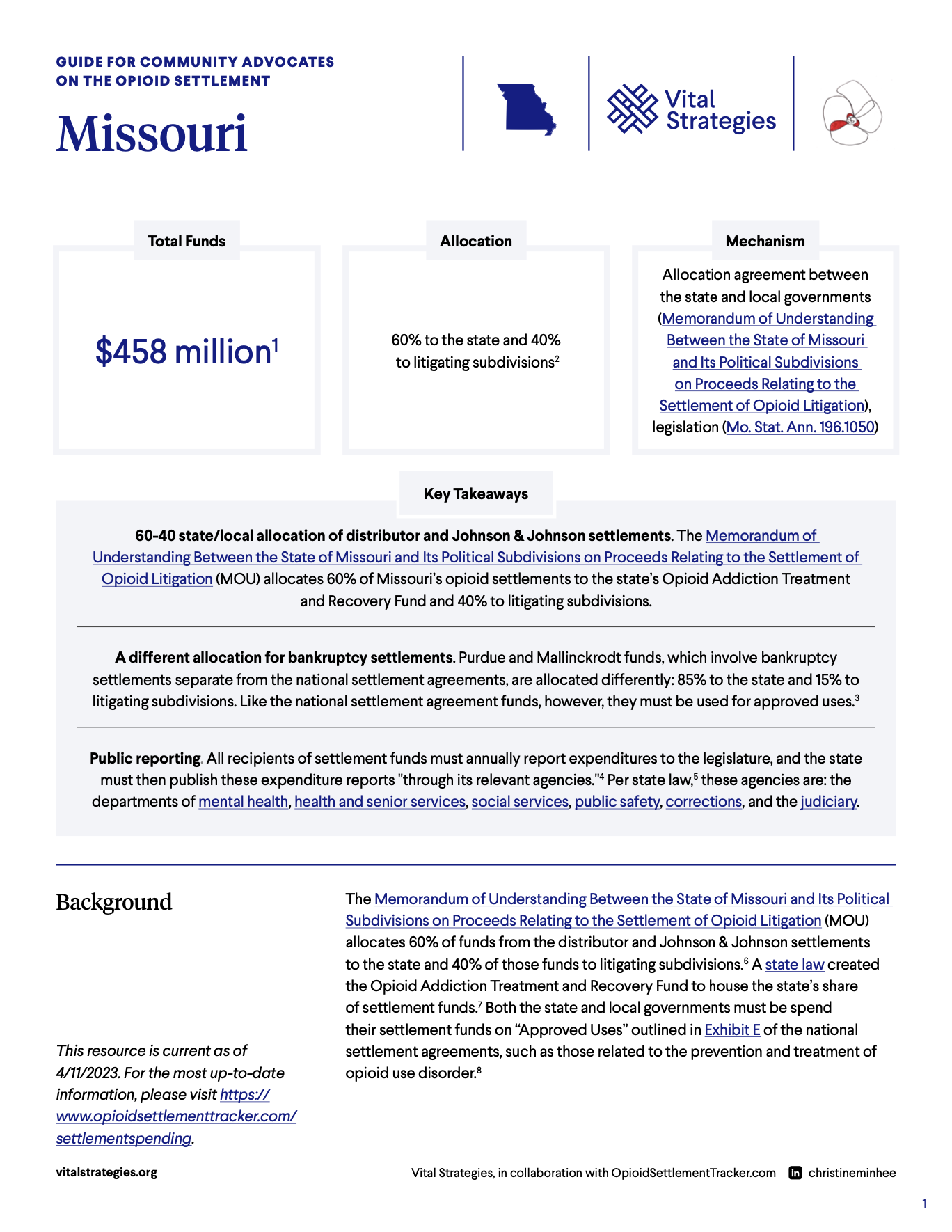
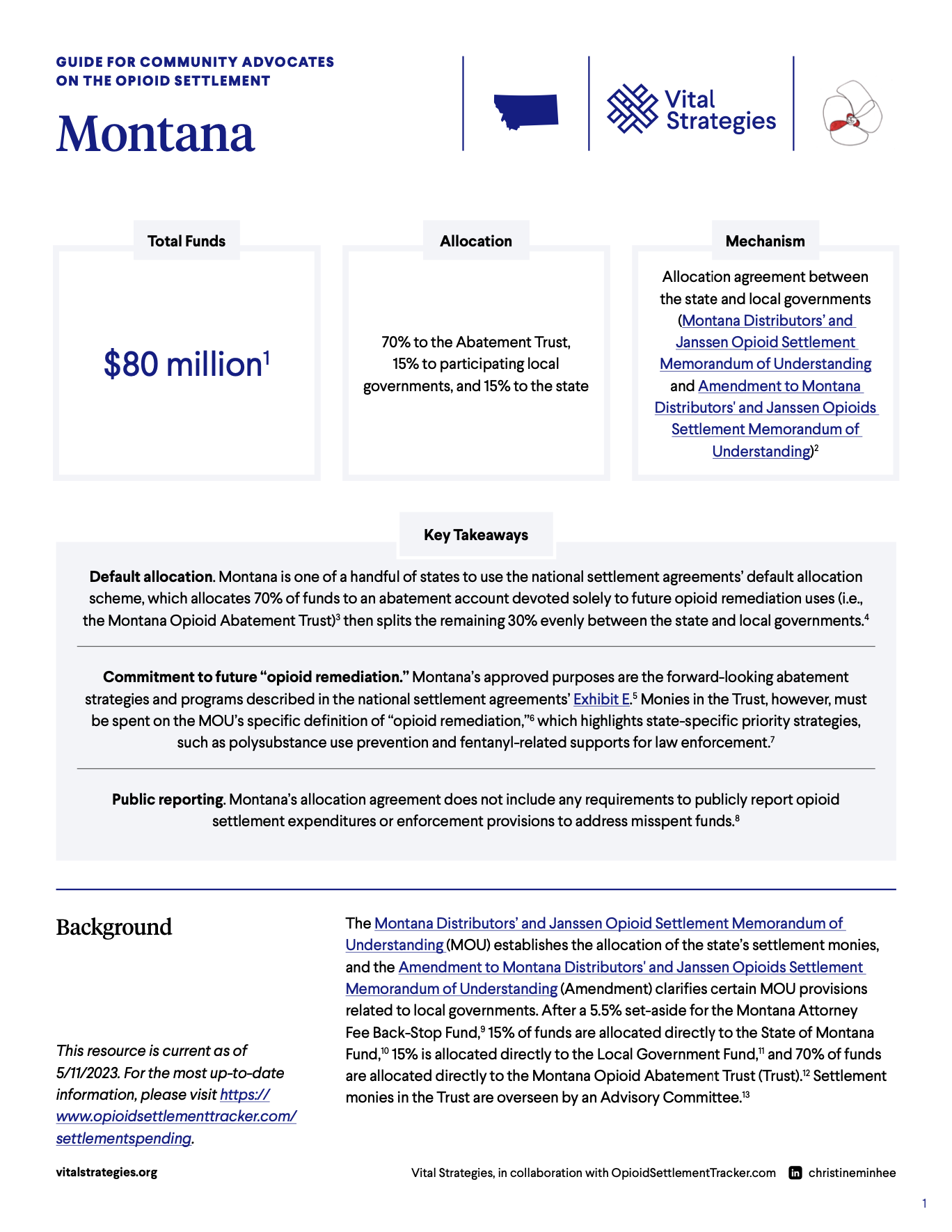
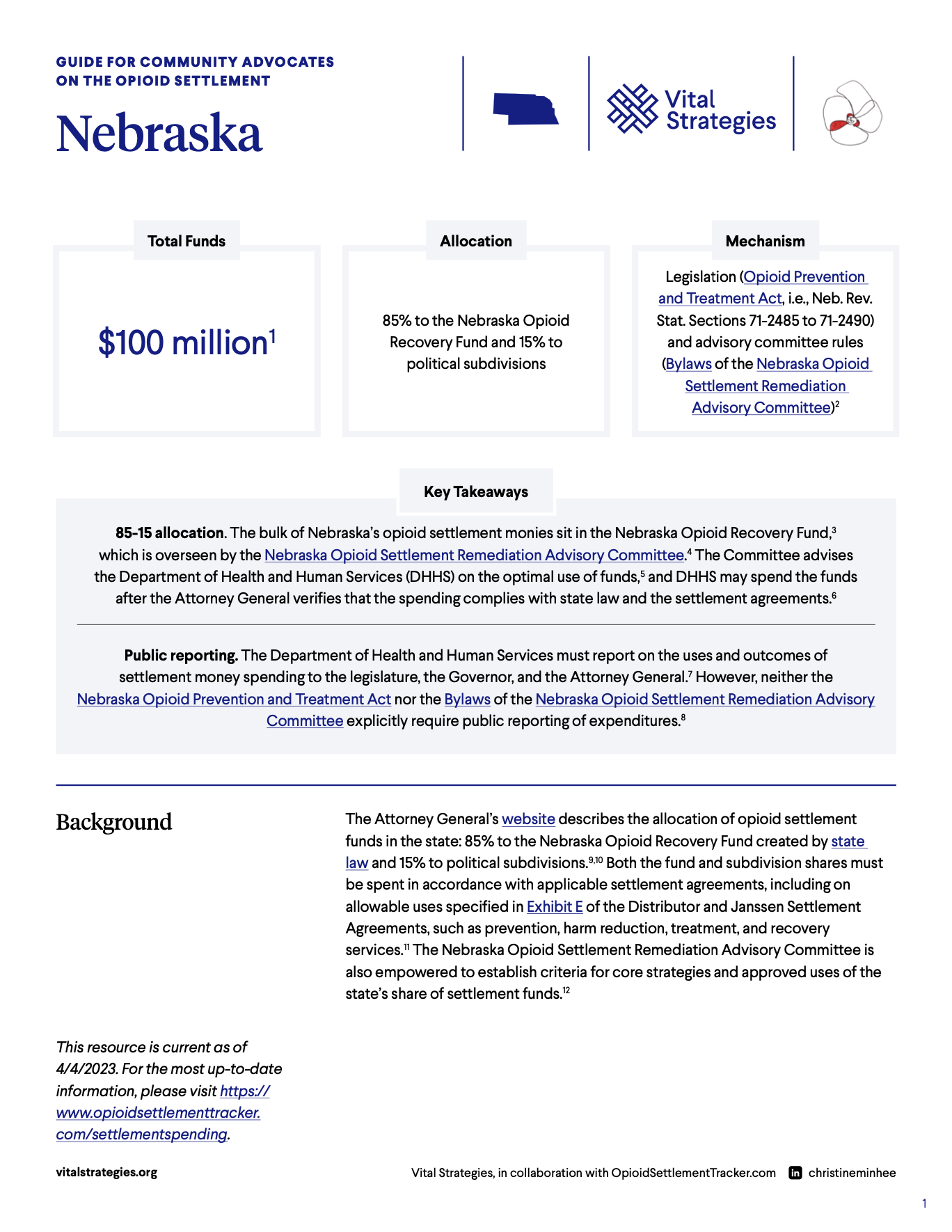

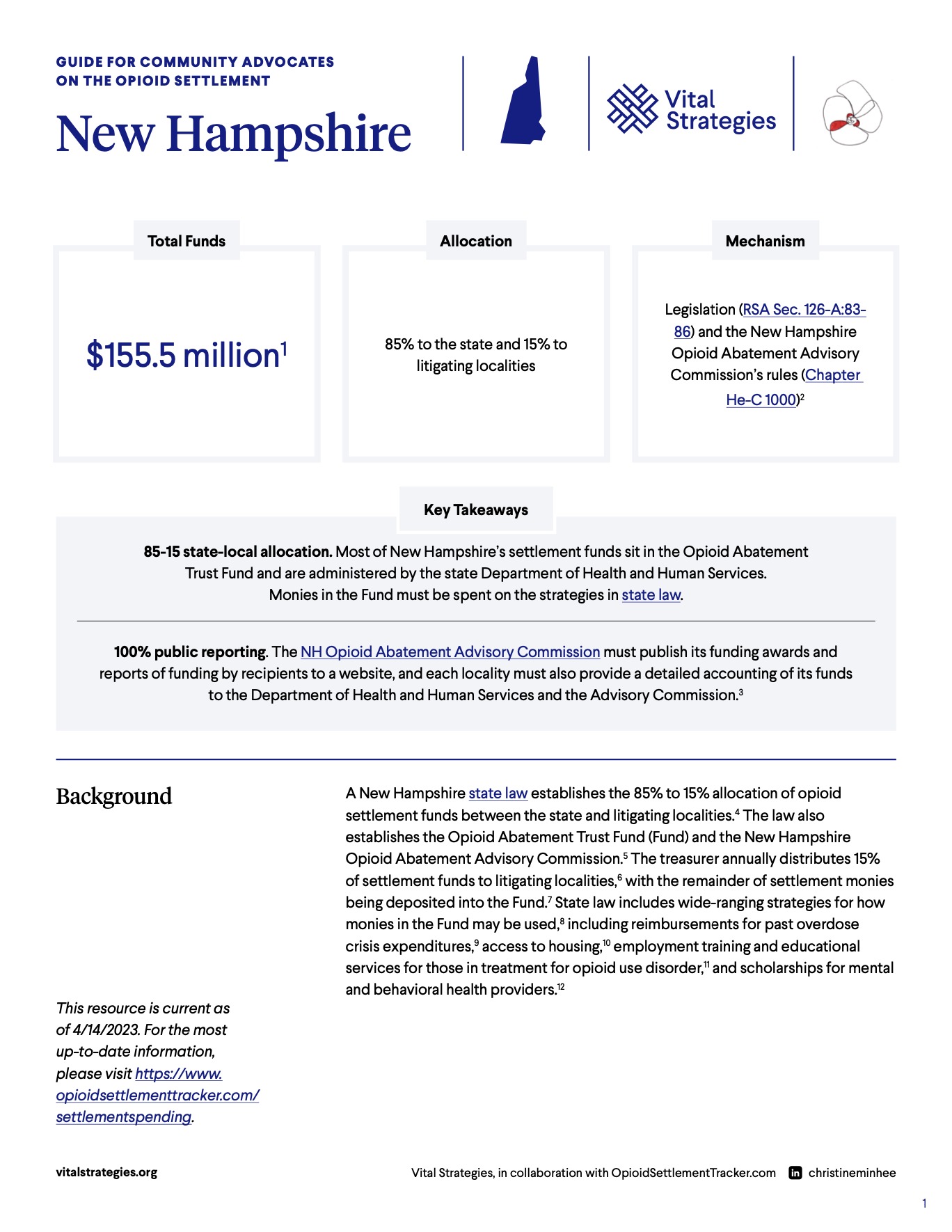

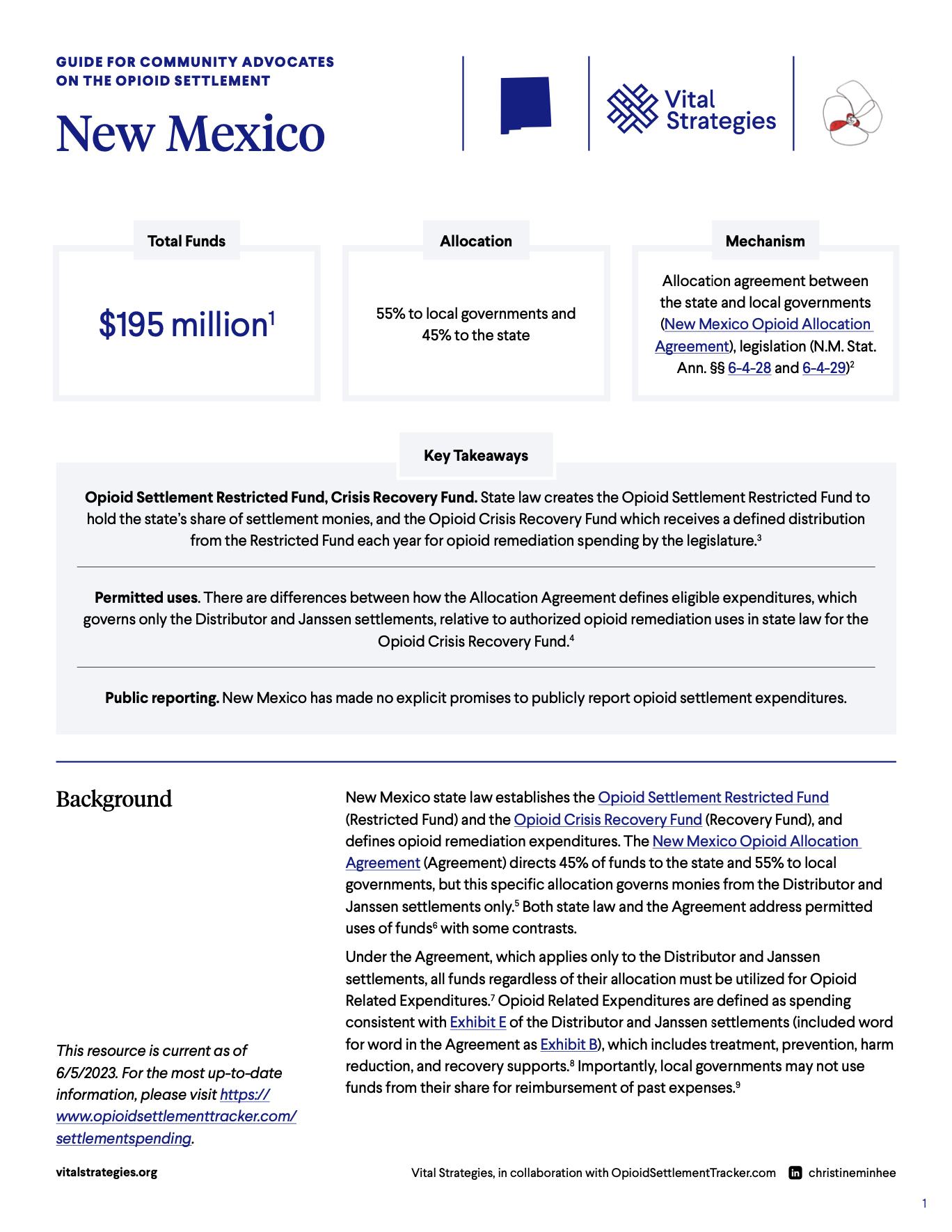
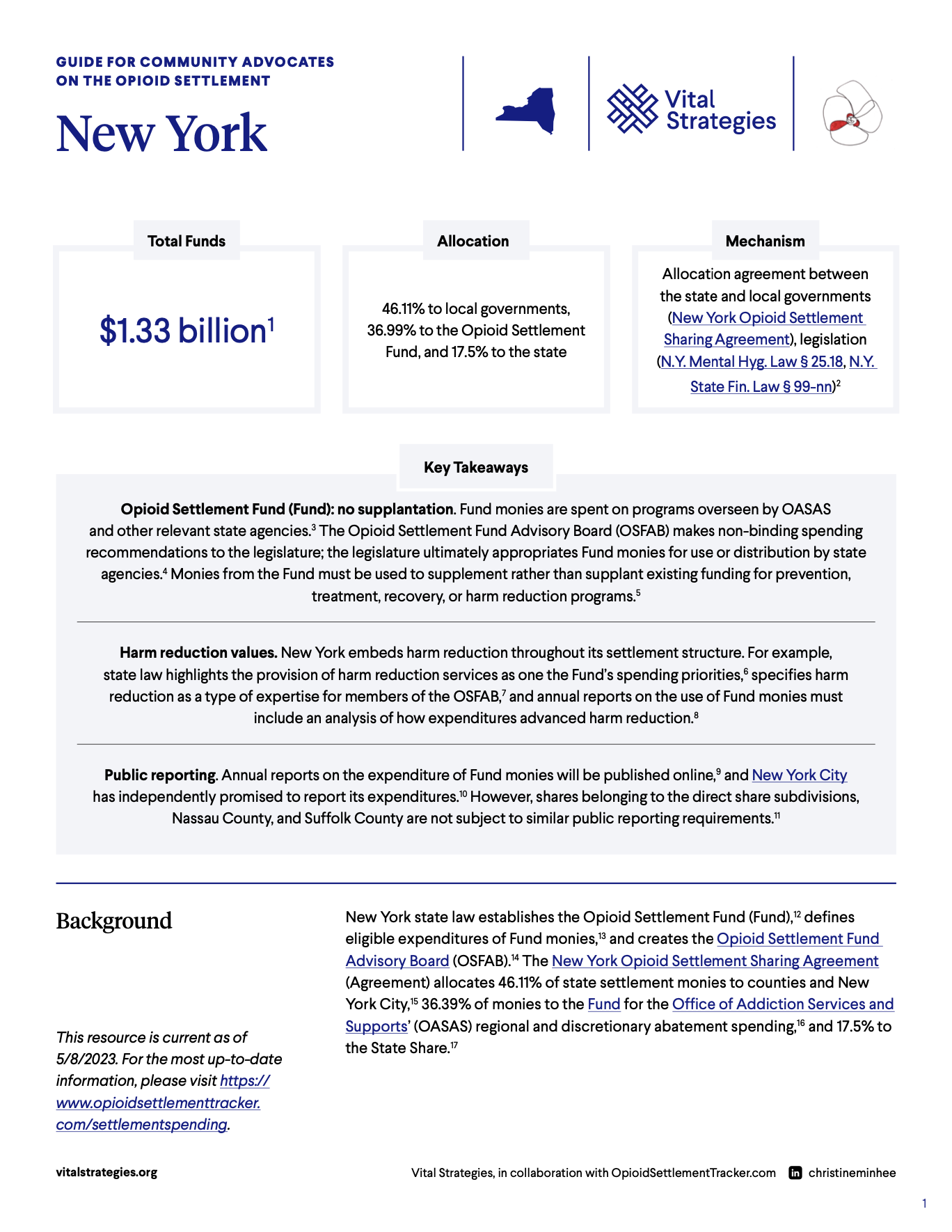
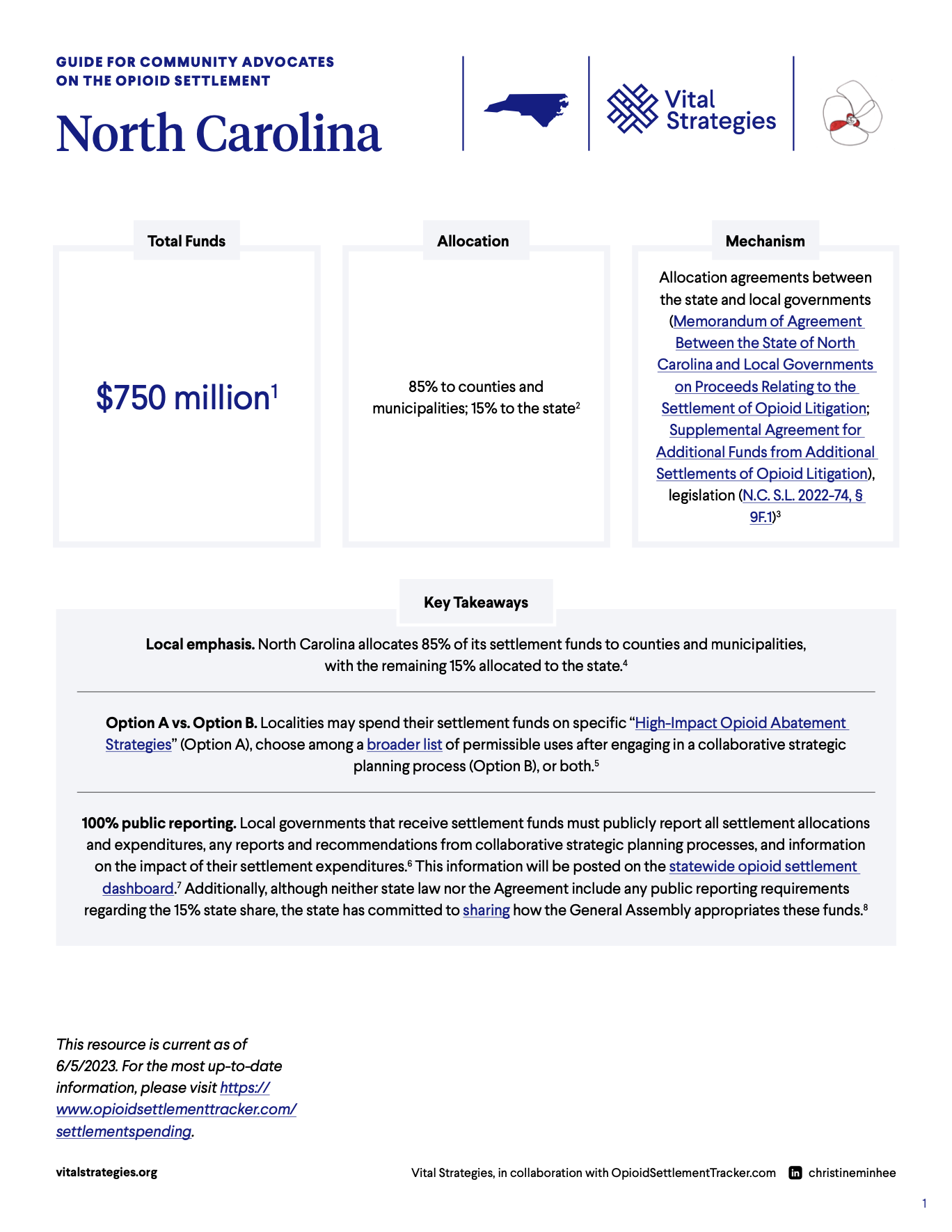
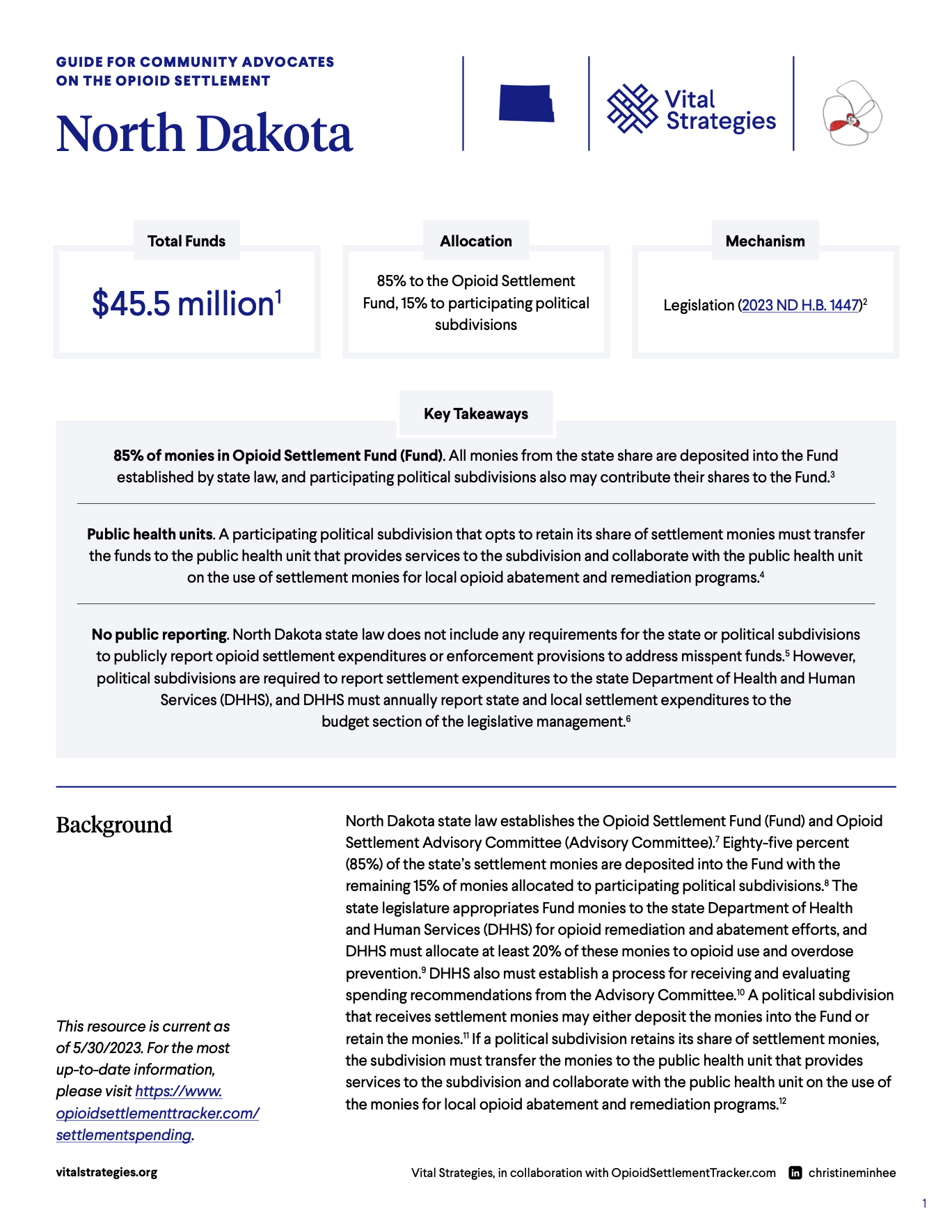
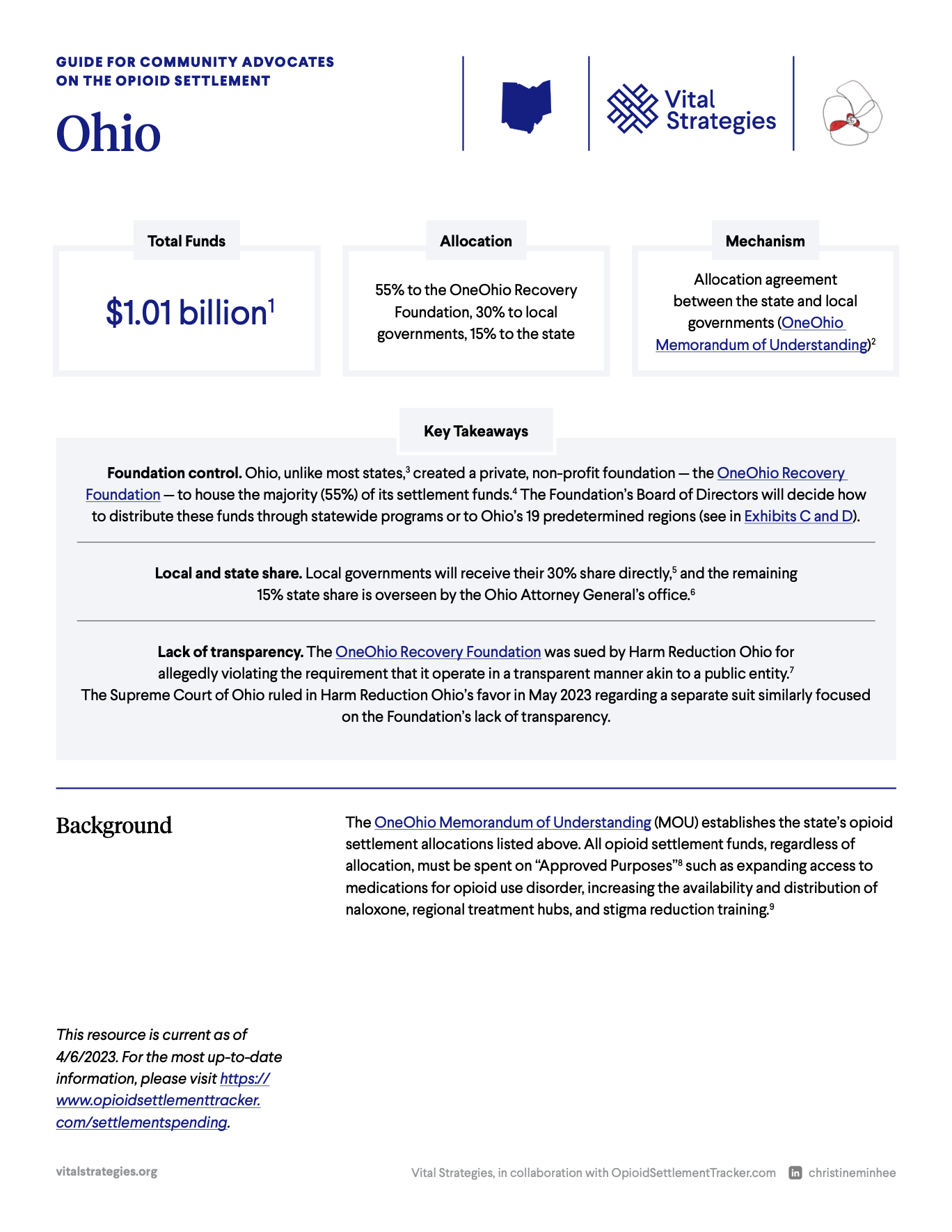


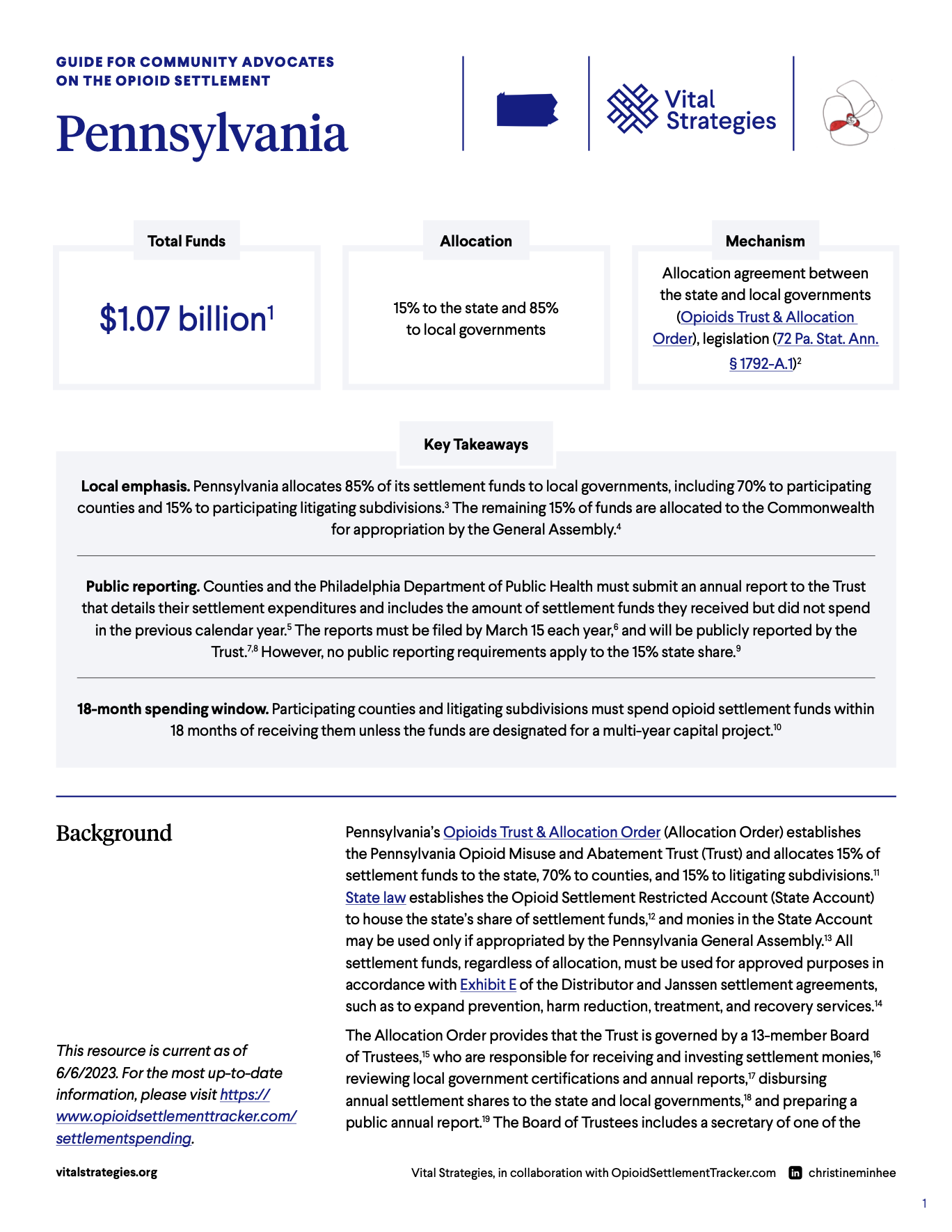
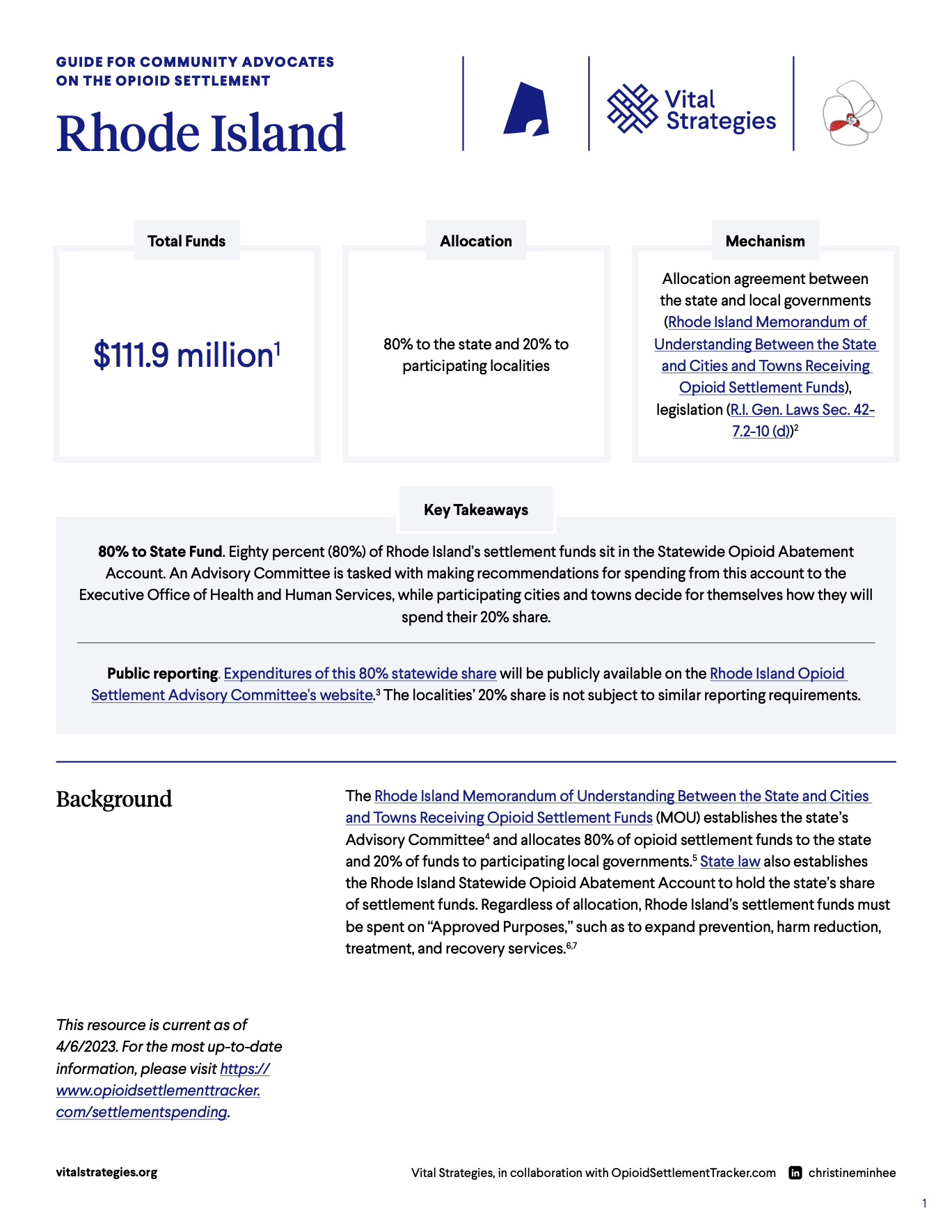
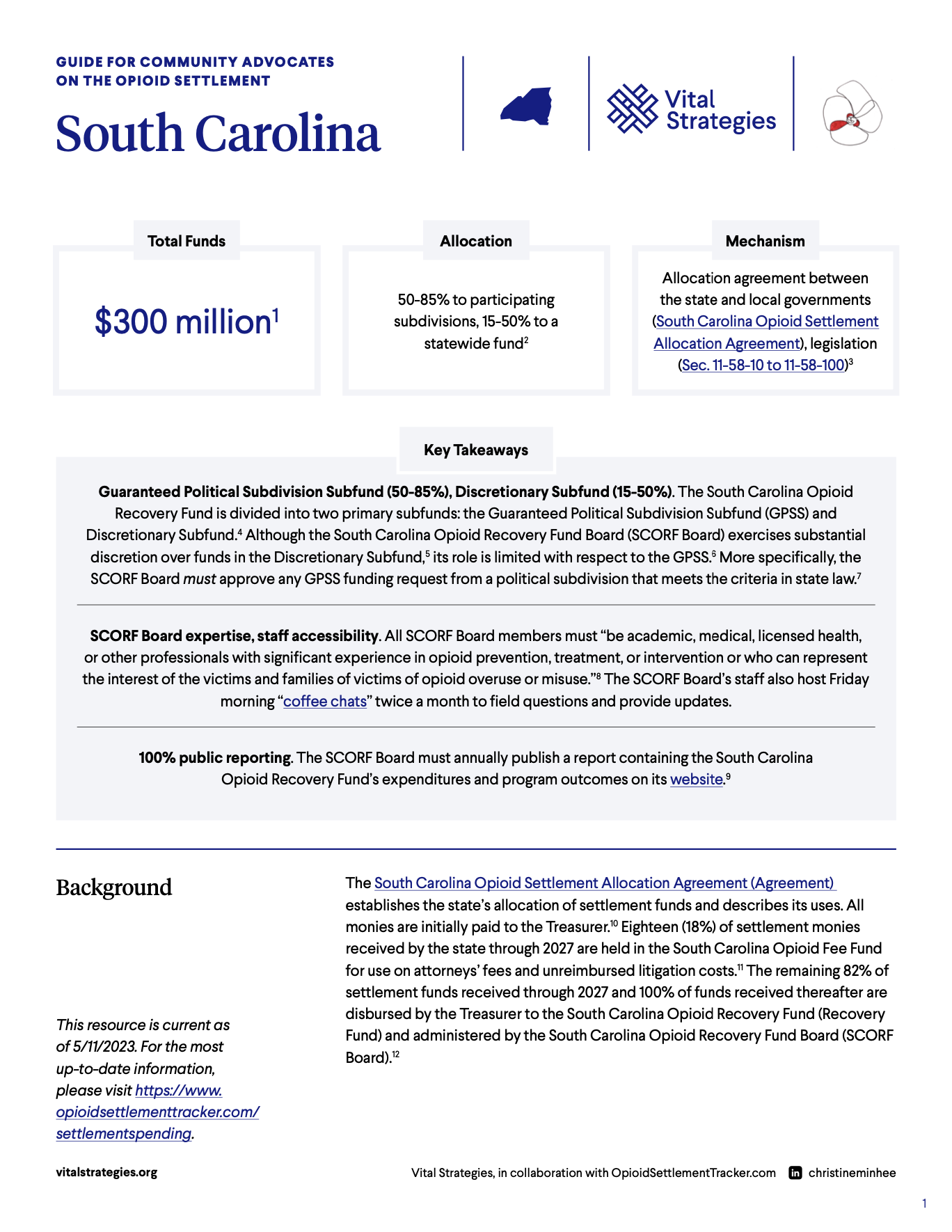
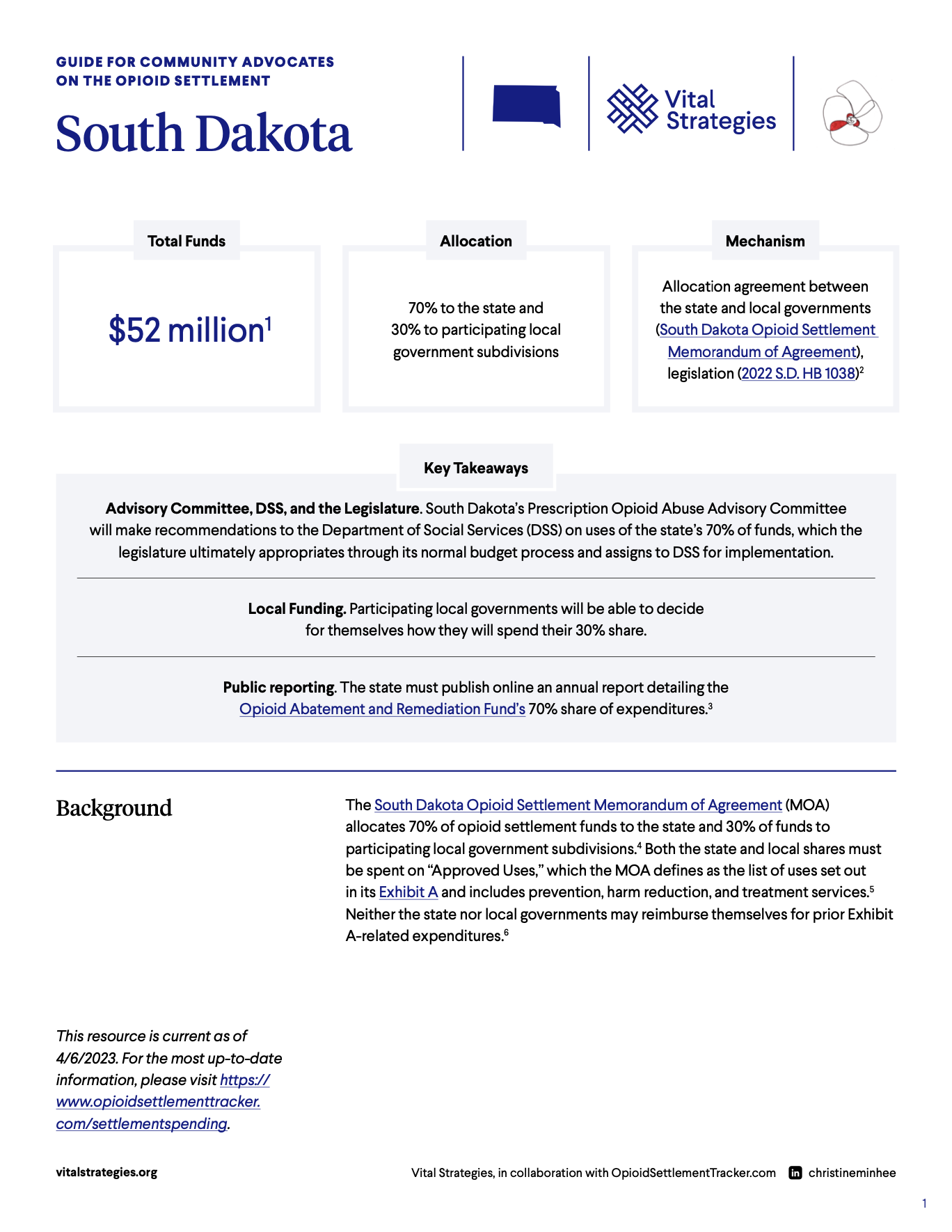



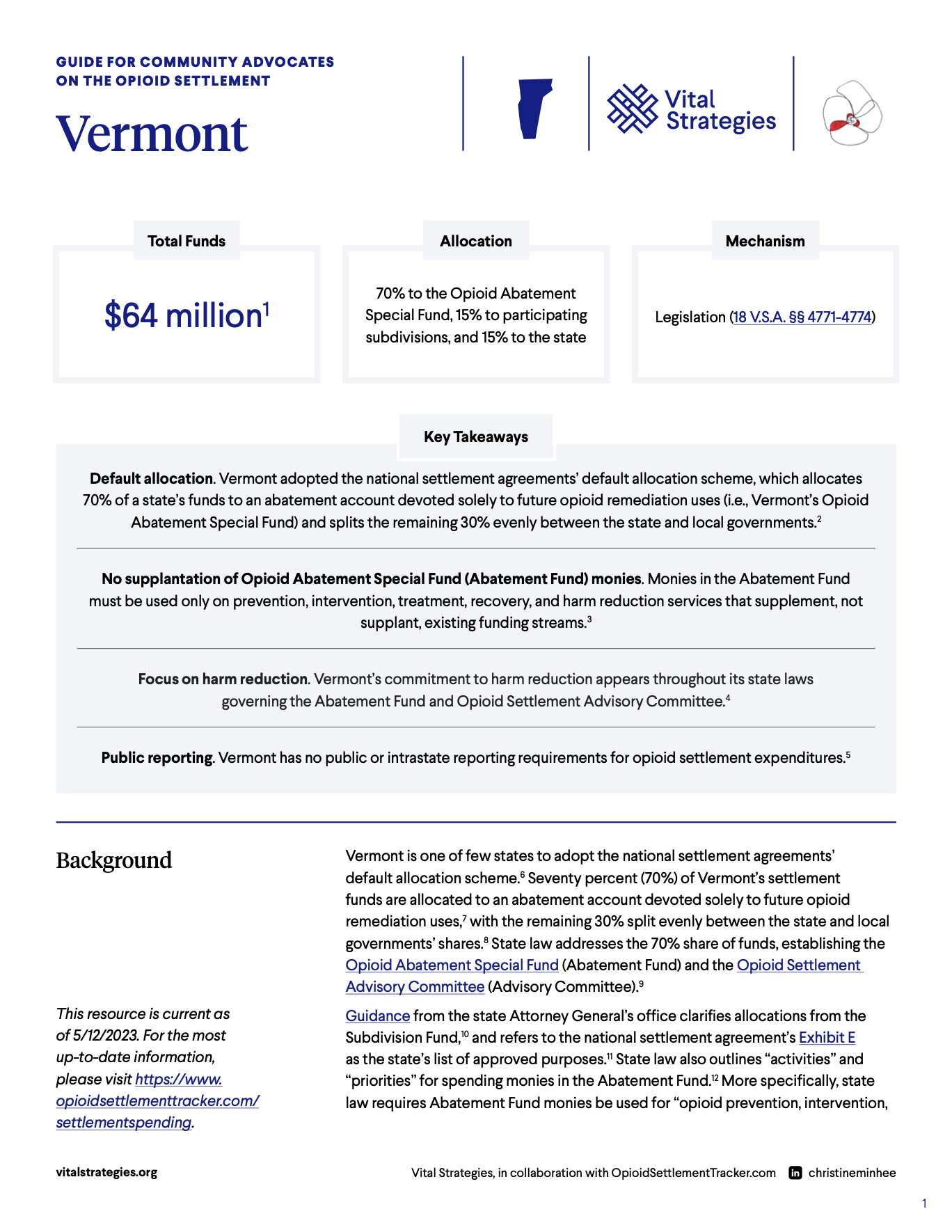


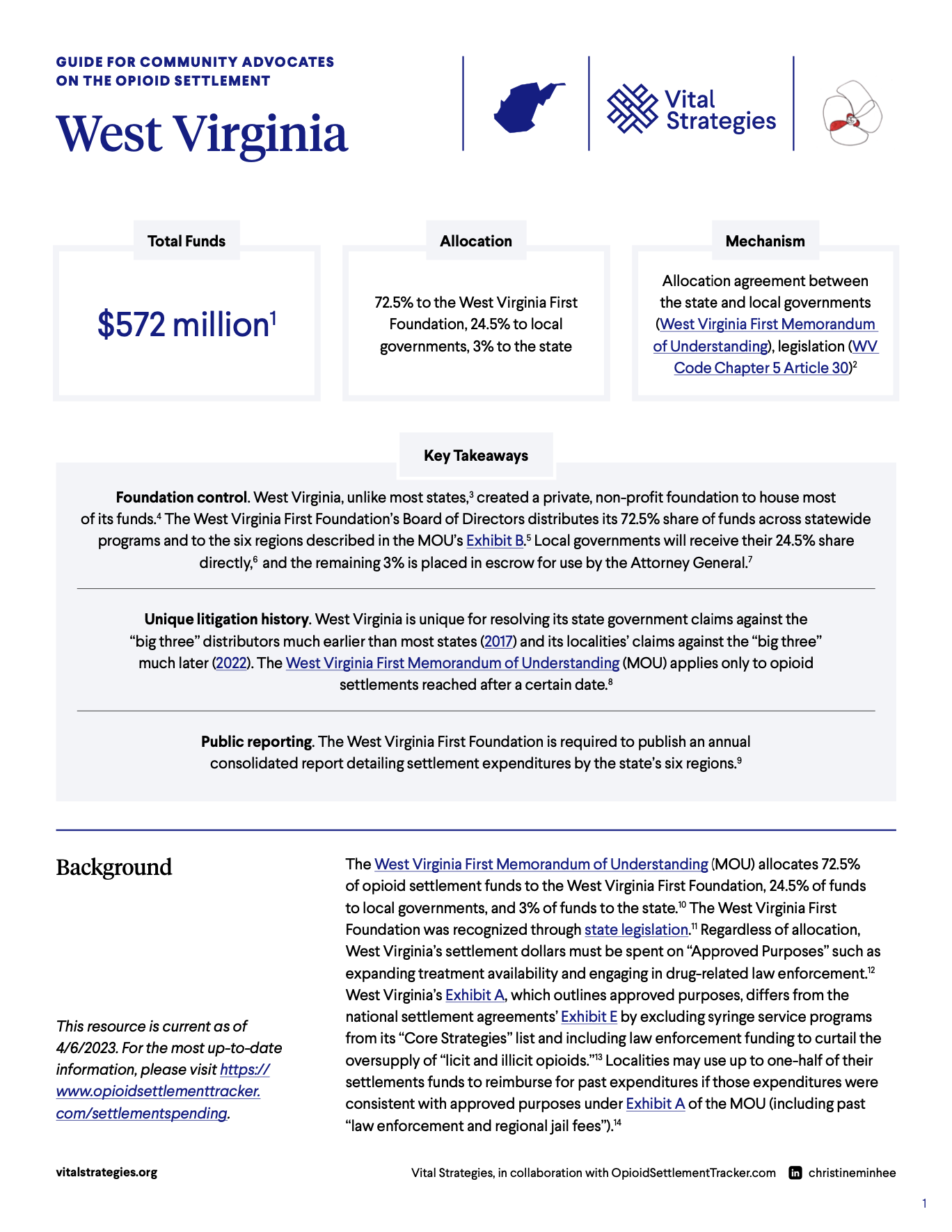

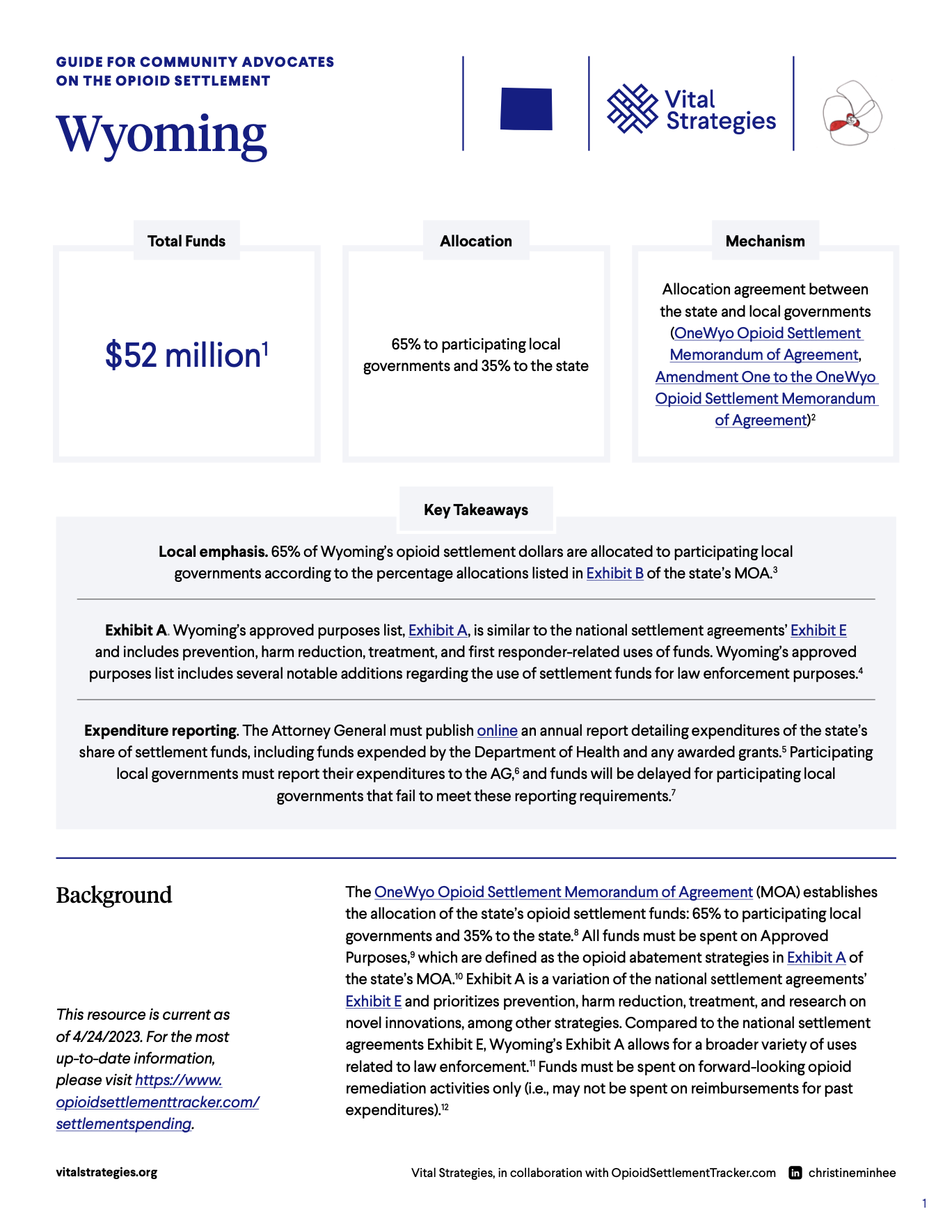
Vital Strategies and I launched these encyclopedic set of guides to equip community advocates with expert-level analyses of each state’s unique opioid settlement spending approach. Each state’s 2023 guide contains the following information:
Key Takeaways. What are the stand-out features of my state’s approach to spending its opioid settlements?
Total Funds and Allocation. How much money is my state getting, and how is my state allocating its monies between state and local governments?
Mechanism. Which documents speak to my state’s approach to opioid settlement spend?
Decision-making Process. Who makes decisions about settlement spending at the state and local levels?
Engaging in the Process. What are the opportunities for community advocates to get involved?
Tracking Funds and Accountability. How do I track funds, and are there any accountability processes built into my state’s plan?
Resources. What are the key, state-specific resources created for opioid settlement advocates in my state?
*Sometime late summer of this year, Vital Strategies and I will be launching our updated Community Guides to include even richer detail. 😎 Questions and comments may be sent to Tips@OpioidSettlementTracker.com.
STATES' OPIOID SETTLEMENT ALLOCATION PLANS (ARCHIVAL FORTHCOMING*)
*Please note: As of April 2024, Christine will no longer use the below spreadsheet to track state-specific opioid settlement news.
Her weekly news tracking will instead appear as part of a forthcoming update to her and Vital Strategies’ Community Guides. Contact for more detail.
UPDATES SINCE ARCHIVAL
*The below list, however, was last updated April 21, 2024.
Iowa: SF 2395 (pending) (“An Act relating to the opioid settlement fund, including appropriations of moneys in the fund”)
Nebraska: 4/15 Legislature press (“Opioid fund changes approved”)
Wisconsin: 4/3 DHS press (“DHS Submits Plan to Legislature’s Joint Committee on Finance on How to Use $36 Million in Opioid Settlement Funds”), 4/18 DHS press (“Law Enforcement Agencies Awarded Grants from State Opioid Settlement Funds”) (DOJ press here)
The below spreadsheet is my 51-state survey of states’ opioid settlement spending plans, i.e., state-subdivision agreements (e.g., North Carolina’s MOA), allocation statutes (e.g., Indiana’s HB 1193), and statutory trusts (Massachusetts’ Opioid Recovery and Remediation Trust Fund). It links to and includes content from my and Vital Strategies’ recently released State-Level Guides for Community Advocates on Opioid Settlements. I update it every Sunday unless something truly chaotic has occurred.
The spreadsheet below was last updated April 10, 2024.* Recent updates at the time: Wisconsin, Michigan, and Pennsylvania. See also Boston and Saipan. Please note: As of April 2024, Christine will no longer be updating the below “LIVE SPENDING UPDATES” column with state-specific opioid settlement spending news. The results of her weekly news tracking will instead appear as part of a forthcoming update to her and Vital Strategies’ Community Guides. Contact for more details.
I read every Google Alert containing the words “opioid” and “settlement” + update the below each Sunday. Whenever I add an article to a state’s “LIVE SPENDING UPDATES” column, I turn any articles older than a month from blue to black.
States with an asterisk (*) are those without plans acknowledged by the Plaintiffs’ Executive Committee.
A note about usage: The information presented herein exists in the public domain, but the compilations themselves belong to me. I create my datasets for public, beneficial uses, so each of them sit under a Creative Commons Attribution-NonCommercial-ShareAlike 4.0 International License, which allows you to “remix, adapt, and build upon [the above] non-commercially” provided that two things occur: (1) I am credited in the process (“Christine Minhee, J.D., OpioidSettlementTracker.com”), and (2) you license whatever you produce using my help under identical terms. Happy to discuss. All rights reserved.
OPIOID SETTLEMENT SPENDING WEBINARS & EXPLAINERS
A collection of my mini-lectures about the opioid settlement spending landscape.
SETTLEMENT SPENDING FAQs
A bit o’ background as to why opioid settlement spending plans are important at all.
(FAQs below are excerpted from my greater Opioid Settlement FAQs tab.)
How do states’ plans relate to the $26 billion global settlement offer made by McKesson, AmerisourceBergen, Cardinal Health, and Johnson & Johnson?
How the $26 billion “national” or “global” settlement relates to other opioid settlements: Though often described as “national” or “global,” that widely reported $26 billion settlement — which resolves opioid crisis-related lawsuits between both sets of government plaintiffs (46 states’ Attorneys General and their participating localities) and just four opioid litigation defendants (“big three” distributors McKesson, AmerisourceBergen, and Cardinal Health and manufacturer Johnson & Johnson) — is not the whole egg. It’s at best the yolk of all opioid settlements expected by governments involved in opioid litigation nationwide, with the rest coming from resolutions with those other defendants not included in the $26 billion deal (e.g., Purdue, Mallinckrodt, McKinsey, and all of the pharmacies).
How the plans listed above relate to the $26 billion settlement, and why its requirements are important for opioid settlement spending watchdogs to study: Given that it makes up the biggest chunk of all anticipated opioid settlements, states and localities have been paying the heaviest attention to its requirements. The most notable among them — and the most valuable for watchdogs to know! — is that all states are required to spend at least 70% of their slice of that $26 billion pie on future opioid remediation…
Will states be misspending their opioid settlement dollars?
Probably not as poorly as they misspent their big tobacco dollars, given that there are clear contractual protections against that outcome. The juiciest among them:
All states are required to spend at least 70% of their share of that $26 billion settlement on future opioid remediation.
An explanation, with receipts (citations):
This 70% “future opioid remediation” threshold requirement — one that all participating states must meet — is baked into the language of the $26 billion settlement agreements: “Any State-Subdivision Agreement … shall be applied only if it requires: (a) that all amounts be used for Opioid Remediation, except as allowed by Section V.B.2, and (b) that at least seventy percent (70%) of amounts be used solely for future Opioid Remediation.” Section V.B.1. Section V.B.2 reiterates this threshold for allocation statutes, while Section V.E.2 provides that “[i]n the absence of a State-Subdivision Agreement, Allocation Statute, or Statutory Trust that addresses distribution, the Abatement Accounts Fund will be used solely for future Opioid Remediation.”
Combined with the way the agreements define Opioid Remediation, and with a little bit of math, this 70% threshold yields two other requirements incumbent upon all participating states:
A maximum of 15% of funds may be spent on opioid crisis-related reimbursement and administrative expenses. Section V.B.1 states that “[i]n no event may less than eighty-five percent (85%) of the Settling Distributors’ maximum amount of payments … be spent on Opioid Remediation,” which Section I.SS defines to include both future Opioid Remediation expenses (the explicitly prospective programming that’ll explicitly go towards abating future overdose crisis harms) and reimbursement and administrative expenses. Subtracting the 70% restricted to future Opioid Remediation, that leaves 15% for reimbursement and administrative expenses.
Non-Opioid Remediation expenses — i.e. roads, gubernatorial helicopters, and the other stuff of big tobacco spending retrospective-supplied nightmares — are capped at 15%. To state it as simply as I can, and to dip into some normative verbiage here: Only 15% of participating states’ funds may be spent on the bad stuff. And if settlement funds are spent on non-Opioid Remediation expenses, the settlement documents’ only reporting requirements attach (see Section V.B.2), which is to say nothing of the many optionally self-imposed expenditure reporting requirements I’ve seen in states’ plans (Arizona’s toothy reporting requirements come to mind here). Given that I’ve devoted my legal career to warning folks about the use of opioid settlement misspending. I find this provision heartening!
Therefore, the default allocation framework described in those $26 billion settlement documents — one that’d divvy up a state’s anticipated payout by giving 15% to the state, 15% to its subdivisions (cities and counties), and 70% to an “Abatement Accounts Fund” (the control over which might also rest with the state, depending on the state) — is just one way to satisfy that 70% future Opioid Remediation threshold.
But if you must know: Most states have wiggled away from the settlement agreements’ default allocation suggestions (that 15%-15%-70% thing). This is normal and predictable; each state must maximize lives saved within what is feasible within their jurisdictional (political) “set and settings” (however dystopic the Tim Leary reference in this context might be). As long as states meet the abatement-related thresholds described above, they can allocate their funds between the state government, local governments, and statutory trusts (if any) however they’d like… provided that the plan is articulated by one of three formats and adopts the settlement agreements’ greater requirements. From most commonly seen to least:
State-Subdivision Agreement — e.g., North Carolina’s MOA — “An agreement that a Settling State reaches with the Subdivisions in that State regarding the allocation, distribution, and/or use of funds allocated to that State and to its Subdivisions. A State-Subdivision Agreement shall be effective if approved pursuant to the provisions of Exhibit O or if adopted by statute. Preexisting agreements … shall qualify” (Distributor pg. 10).
Statutory Trust — e.g., Massachusetts’ Opioid Recovery and Remediation Trust Fund — “A trust fund established by state law to receive funds allocated to a Settling State’s Abatement Accounts Fund and restrict any expenditures made using funds from such Settling State’s Abatement Accounts Fund to Opioid Remediation” (Distributor pg. 11).
Allocation Statute — e.g., Indiana’s HB 1193 — “A state law that governs allocation, distribution, and/or use of some or all of the Settlement Fund amounts allocated to that State and/or its Subdivisions. In addition to modifying the allocation set forth in Section V.D.2, an Allocation Statute may, without limitation, contain a Statutory Trust, further restrict expenditures of funds, form an advisory committee, establish oversight and reporting requirements, or address other default provisions and other matters related to the funds” (Distributor pg. 1).
Are the risks of settlement misspending real?
Yes. Examples abound. Recently, New York’s Governor Cuomo used his state’s McKinsey settlement winnings to “supplant state aid rather than to supplement” the state’s overdose crisis prevention efforts, prompting state legislators to urge the passage of legislation that’d “ensure an ironclad, incremental lockbox for future settlement funds.” But the most laugh-cry example comes from now-Senator Joe Manchin; back when he was governor of West Virginia in 2007, he tried using his state’s Purdue settlement winnings to buy himself a personal helicopter.
As explained by Judge Polster himself: “The problem is that in a number of States any money that is, that a state attorney general obtains, either by victory in court, litigated judgment, or settlement, goes into the general fund. And the men and women who control what happens in the general fund are the elected state representatives and senators. That’s what they do. And that’s what happened in the tobacco litigation. Over $200 billion, far more than 90 percent of that was used for public purposes totally unrelated to tobacco smoking, lung cancer, whatever. And I believe that’s why we have all these counties and cities that filed separate lawsuits, to make sure that doesn’t happen again. ... [Any settlement] has to address the problem of putting money into the state general funds or else it isn’t going to fly.”
Why have states’ opioid spending plans taken the form of contracts and legislation?
As suggested by experts in Opioid Litigation Proceeds: Cautionary Tales From The Tobacco Settlement: “[R]evenue laws vary from state to state as do the specific language in settlement agreements related to the direction of money to general or restricted funds, yet legislation may be an effective measure to ensure funds are used toward responding to the crisis.” This is why we should generally be happy to see so many statutory trusts and allocation statutes boppin’ about in the spreadsheet above.
Additionally, contracts between the state and local governments have emerged as a vibrant, creative, and politically expedient (e.g., legislature-avoiding) way of articulating spending goals. Bloomberg Law correctly notes that settlement agreements between plaintiffs and defendants (i.e., from outside parties) can rarely dictate intrastate political processes. (“Some state attorneys general don’t have the power to allocate funds that belong to the legislature … . While a master settlement is a contract between parties, … it can’t change a state’s power structure.”) However, contractual agreements between intrastate government plaintiffs — e.g., the memoranda of understanding, state-subdivision agreements, intrastate allocation agreements between state and local governments — are effectively agreements to do so beforehand that manage to avoid offending constitutional separation of powers considerations.





